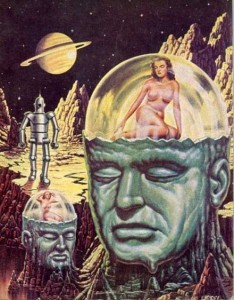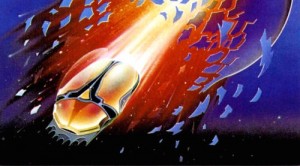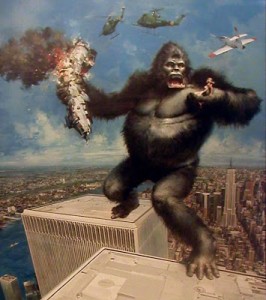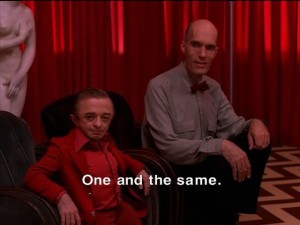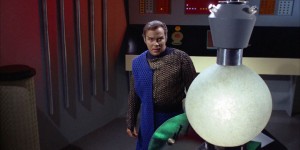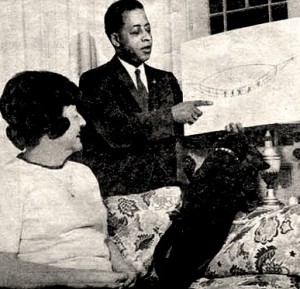The Nightshirt Sightings, Portents, Forebodings, Suspicions
Coincidence, Chaos, & Archetypes in Our Science-Fictional World
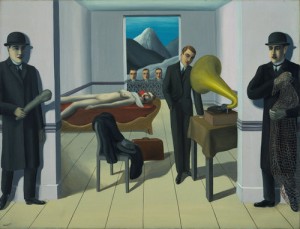
You don’t have to be a hardheaded materialist skeptic or an atheist to be troubled by the idea of synchronicity. The fundamental mystery—or really, outrage—of synchronicities is they seem arranged, stage managed, in a way that is impossible without imagining an active higher intelligence taking interest in guiding us and arranging the events of the wider world to produce unmistakeably uncanny outcomes. Even if we believe in God, many people aren’t comfortable living in a world of miracles and signs.
This was the problem faced by Philip K. Dick, whose Christianity couldn’t countenance fully divine meddling in his psyche and life. The story had to be more complex and also more rational. Hence, he tended to think that the synchronicities he experienced in 1974 reflected his own enlarged self haunting him from an orthogonal dimension of time, perpendicular to the four spacetime dimensions we ordinarily experience.
Consciously being open to coincidence but failing to recognize our own role in creating significant moments, we inevitably imagine a Higher Knower. But this is a mistake.
My last post sparked an interesting discussion in the comments about the apparent role of coincidence in synchronicities if they are really, as I argued, cases of misrecognized precognition or premonition. For instance, even if Jung’s famous scarab arriving at the window of his office was a purely random event that his patient had dreamed about the night before, there is still a coincidental element to it: Why a scarab, which has an archetypal meaning connected to the patient’s therapeutic situation, as opposed to some other insect?
Here’s where I think we really need to take seriously the revised picture of time that Dick grappled with through his 8-year frenetic journaling in his Exegesis: What is the connection between the archetypal world and the multidimensional nature of time? In a Eureka moment (not unlike the hundreds recorded by the manic Dick), I think I figured it out: Archetypes are an illusory effect produced by our failure to recognize self-confirmatory actions (feedback loops) made possible by the looping nature of time. Temporal feedback loops amplify the personal significance of symbolic formations, which (because we fail to recognize psi) appear as somehow objective or external to us.
 For reasons I discussed in my Psi of Regret post, most information from the future should be negated by one’s own and others’ willed actions; but in a minority of cases, a self-confirming feedback effect could arise which would actually intensify or amplify the significance of the stimulating event in the future. This would happen specifically when that event involves a minor random coincidence (which are myriad) and/or fulfills some kind of unconscious thought or desire we had harbored.
For reasons I discussed in my Psi of Regret post, most information from the future should be negated by one’s own and others’ willed actions; but in a minority of cases, a self-confirming feedback effect could arise which would actually intensify or amplify the significance of the stimulating event in the future. This would happen specifically when that event involves a minor random coincidence (which are myriad) and/or fulfills some kind of unconscious thought or desire we had harbored.
Through this time-loop mechanism, minor coincidences, when they resonate with our own personal meanings and priorities, can be the nuclei of major significant moments (synchronicities) as well as meta-symbols (archetypes). Small coincidences, in other words, may be like grains of sand around which time’s oyster builds Platonic-Jungian pearls.
Bootstrapping Ourselves Toward Meaning
The idea of information from the future reaching us in the present should be unproblematic to parapsychologists and Forteans, yet we still tend to think of it somehow as a very special case. But if we grant the experimental results of Daryl Bem and Dean Radin and the observations of J.W. Dunne and others, then information must indeed be constantly rippling backwards in the time stream; this would have to produce all the paradoxical effects familiar from time travel stories in science fiction: doubling or multiplication or intensification of information (not unlike what happens in the interesting 2004 sci-fi film Primer), as well as self-cancelling effects such as I discussed in the context of Dune Messiah, and perhaps even wholesale self-negation (the famous grandfather paradox). If I am right about the future not being etched in stone (or glass, as in the Minkowski glass football)—that is, as subject to free will—then precognitive material cannot be about what is definitely going to happen but about what is probabilistic, and much of that information will be rendered inaccurate by our willed actions, and thus we would have no way of knowing it (i.e., because it didn’t come true or wasn’t close enough to how events unfolded to be discernible). It wouldn’t even be information, just noise.
Instead of our future selves meddling in the past, our unconscious minds are constantly receiving and reacting to future information without knowing it comes from the future.
However, in special circumstances, for instance when there is a slight perceived (and random) coincidence, such as between a specific genus of insect and the theme of therapeutic rebirth, it could instead have the effect of entraining our actions to the signal, in turn amplifying the felt significance of the signal into the past, generating a precognitive or premonitory experience which in turn feeds forward to intensify the uncanniness of the stimulating event, in turn boosting the signal into the past, and so on … The result would be an informatic/emotional time-loop feedback effect centered on what emerges as a truly uncanny, meaningful, and even decisive coincidence (the ’synchronicity’) that could even alter the course of a person’s life in a significant fashion going forward.
Within Jung’s larger and less radical paradigm of “individuation,” the unconscious is ever seeking out opportunities to progress and develop and change toward wholeness, and its capitalization on significant coincidences provides a way for the individual to bootstrap him/herself toward integration. The unconscious has no sense of time, so it doesn’t recognize this operation of atemporal time-looping—that is, the artificiality of the apparent coincidence (i.e., the fact that the person him/herself created the apparent coincidence through his/her actions and attributed it to objective external reality). The tendency of ‘synchronistic’ events to have a recursive, fractal, or self-similar quality, in some way being ‘about’ the whole notion of synchronicity or coincidence, reflects the tendency of the coincidence-receptive person to be attuned to coincidences in the first place. It is, quite literally, self-fulfilling prophecy.
Jung and Plato Must Die (that Psi May Live)
Thus the kinds of events that spark an emotional ripple into the past will be ones that support the ‘prophetic enjoyment’ I mentioned in the last post: Synchronicities are self-confirming effects produced by misrecognized precognition within an overall attitude of receptivity to mystery, magic, and meaningful coincidence. Belief in synchronicity produces synchronicity, which further reinforces the belief. In a larger sense, this mechanism may underlie the “law of attraction” in all its forms. It really is just like the “strange attractor” in Chaos Theory (and which is also identical to what Lacan and Žižek call the “symptom”).
 What this suggests—and this is my Eureka—is that “archetypes” as such—as well as the Platonic world of “forms” that Dick suggested was the “fifth dimension” (printing out archetypes on the paper of history as on an IBM Selectric typewriter)—are really an illusory or anamorphic effect produced by not seeing or recognizing these self-confirmatory time loops, these informational/emotional eddies in the spacetime continuum, and failing to see our own role in feeding them through our perceptions and actions. We ourselves make meaning, including the intensified meaningful nuclei in the collective unconscious that so fascinated Jung and that formed the centerpiece of Platonic metaphysics.
What this suggests—and this is my Eureka—is that “archetypes” as such—as well as the Platonic world of “forms” that Dick suggested was the “fifth dimension” (printing out archetypes on the paper of history as on an IBM Selectric typewriter)—are really an illusory or anamorphic effect produced by not seeing or recognizing these self-confirmatory time loops, these informational/emotional eddies in the spacetime continuum, and failing to see our own role in feeding them through our perceptions and actions. We ourselves make meaning, including the intensified meaningful nuclei in the collective unconscious that so fascinated Jung and that formed the centerpiece of Platonic metaphysics.
At times, Dick came close to saying this: He suggested that synchronicities occur because we in the future are time traveling, cultivating our own development; that our own enlarged consciousess has the power to “stage manage” not because it is a white-bearded deity sitting up in a cloud reaching down and playing with us like chess pieces, but because of the nature of time itself. Coincidences may be the product of time tampering, our own time tampering in the future.
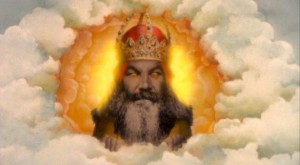 Where I’m departing from this notion is in emphasizing misrecognition and the role of the unconscious: Instead of our future (conscious) selves meddling in the past, our unconscious minds are constantly receiving and reacting to future information without knowing it comes from the future; through our actions, we thus sometimes confirm this information, particularly when it resonates with our priorities and unconscious beliefs about meaning or our own significance in the bigger cosmic picture. That sort of information will act as an ‘attractor’ in the Chaos Theory sense and give rise to the illusion of BIG coincidences and the meta-symbols that are necessary (in Jungian thinking) to make sense of them.
Where I’m departing from this notion is in emphasizing misrecognition and the role of the unconscious: Instead of our future (conscious) selves meddling in the past, our unconscious minds are constantly receiving and reacting to future information without knowing it comes from the future; through our actions, we thus sometimes confirm this information, particularly when it resonates with our priorities and unconscious beliefs about meaning or our own significance in the bigger cosmic picture. That sort of information will act as an ‘attractor’ in the Chaos Theory sense and give rise to the illusion of BIG coincidences and the meta-symbols that are necessary (in Jungian thinking) to make sense of them.
We live in a world that curves and bifurcates and loops back on itself, and these loopings and crossings and doublings and cancellations exert a shaping force on our lives and larger events via what we call psi, but we (a) think linearly and do not believe in time travel, (b) generally disbelieve in psi, and (c) fail to include the knower in the known even when we do believe in those possibilities. Consciously being open to coincidence and ‘larger meaning’ but failing to recognize our own role in creating significant moments, we inevitably imagine a Higher Knower who recognizes and certifies these eternal forms or archetypes, stage-managing these amazing occurrences as signals or signposts for us. But this is a mistake.
I’m suggesting we kill both Jung and Plato here in one stroke … maybe even God. Not only synchronicities but also archetypes and Ideal Forms are illusions caused by our failure to recognize the truly science-fictional way that informational-emotional time loops may intensify the potency of confluent events and symbols in our lives, and the role we ourselves play in the process.
We live in a science-fictional universe. To move forward, we need to recognize that fact.
Scarabs & the ‘Send’ Button: Synchronicity as Misrecognized Psi
During the weeks I was researching my previous post on 9/11 and premonitions of trauma, I had a very powerful, uncanny experience that contained, in miniature, all of that post’s themes. It began with an unusually bad day at work, where I’d felt extremely guilty over a group email I had sent to coworkers that, because of poor word choice, could have been construed as insulting to one of the people cc-ed on it. After I hit “Send,” I started to stew about it, feeling embarrassed and angry at myself for my lack of tact. This was near the end of the workday, and I felt bad about it all the way home on the metro.
Awaiting me on the doorstep was a brown paper package containing a book I’d ordered more than a week earlier and forgotten about. I order lots of used and out-of-print books on Amazon and eBay, which often take weeks to arrive, so I’ve usually forgotten them by the time I get them. This one happened to be by a former professor of mine in graduate school, on the subject of paradoxes. What stunned me was the return address on the package was a woman with the same very unusual surname as my professor, who (I assumed) could only be his wife—her Amazon Seller name was different so I’d had no idea it was her. This was obviously a remaindered copy of her husband’s long-forgotten book.
The cosmos seemed to be serving up my guilt to me on a platter. But in fact, it was just serving me an emotional time loop I didn’t immediately fathom until I delved into the matter.
This by itself would not be so amazing, but what was stunning was that I had for 25 years harbored regret over a group bulletin-board message I had sent to fellow students and faculty in my graduate department, in which, through tactlessness and poor word choice, I feared I inadvertently hurt the feelings of this woman, my professor’s wife. In other words, my current emotional situation about a work email a couple of hours earlier that day was a precise mirror image of a situation two and a half decades ago involving precisely the person who had mailed me this book on paradox.
Tactlessly hurting people in emails or bulletin board messages is not the sort of thing I do commonly—in fact, I couldn’t think of another instance in those 25 years in which quite this same thing had occurred. This book of my old professor, arriving on my doorstep, was like a bizarre short circuit between two highly unusual events a quarter century removed in time.
… Or at least, that’s how it seemed, until I took a closer look.
Temporal Bias and Beetlemania
The book on my doorstep was very much like the most famous object in the annals of meaningful coincidence, the scarab beetle that tapped on the window of Carl Jung’s Zurich office, described in his book Synchronicity:
A young woman I was treating had, at a critical moment, a dream in which she was given a golden scarab. While she was telling me this dream, I sat with my back to the closed window. Suddenly I heard a noise behind me, like a gentle tapping. I turned round and saw a flying insect knocking against the window-pane from the outside. I opened the window and caught the creature in the air as it flew in. It was the nearest analogy to a golden scarab one finds in our latitudes, a scarabaeid beetle, the common rose-chafer (Cetonia aurata), which, contrary to its usual habits had evidently felt the urge to get into a dark room at this particular moment. I must admit that nothing like it ever happened to me before or since.
We tend to think, when these things happen, that some higher organizing principle or intelligence has prearranged these coincidences in our life to act as a kind of sign. That is precisely how I felt as I opened the package from my professor’s wife. I could imagine her putting the book in the brown envelope, penning my address on the side, and muttering “Here you go, asshole” … and that this was part of a larger cosmic design to serve my own tactless or thoughtless behavior up to me on a platter. Frequently of course, synchronicities have a positive feeling, like God winking or giving us the thumbs up—or in Jung’s case, providing confirming evidence of a deeper mystery about the mind and cosmos.
But as I argued in my last post, there’s a much simpler explanation for many (albeit not all) such occurrences, so long as we grant that some kinds of information—namely, our own complex emotional reactions to future traumatic situations—can travel backward in time and influence us in the present, if only on an unconscious level.
Our own complex emotional reactions to future traumatic situations can travel backward in time and influence us in the present, if only on an unconscious level.
Much laboratory evidence has been gathered, particularly by Daryl Bem and Dean Radin, for emotional responses to imminent events. This could well explain the most common type of “synchronicity”: thinking of a certain person and then receiving a call or email from them, or thinking of an unusual object and then seeing one. We naturally interpret the present as caused by the past, because the bulk of causality seems to flow in a forward direction, and this is also how we naturally interpret the flow of our own thoughts. Thus, a causal heuristic, or temporal bias, causes us to habitually overlook natural forms of precognition and presentiment and thus misconstrue their effects as uncanny coincidences: Having a thought about our old friend X, which we naturally assume arose from our ordinary, forward train of thought, may actually have been stimulated by a presentiment or premonition of their imminent call.
J.W. Dunne noted in An Experiment with Time that this bias to interpret the present in terms of the past causes us to miss the precognitive elements in our dreams as well. Even people who assiduously record and interpret their dreams (like me, for decades, until reading Dunne’s book) rarely go back to those records in the future, in any systematic fashion, to identify possible precognitive material. Yet when you do—specifically over the next 1-2 days—a certain amount of precognitive stuff becomes quite evident. (When you take the further step of free-associative interpretation on bizarre symbols, even more “future” material turns up.)
It turned out that this principle is actually the only possible explanation for my own ‘synchronistic’ experience … and I argue it even explains Jung’s scarab much better than Jung’s own theory.
An Ass Out of You and Me
Late on the evening I received the book in the mail, I rose from bed—I was unable to sleep in my weird excitement over the coincidence—and I used my most powerful Google-fu to verify that the woman who had sent my package was indeed my old professor’s wife. Lo and behold, I discovered she was not. She was, probably, an in-law, married to another man with the same last name—a man not too far in age from my old professor, and thus likely his brother or cousin (not a son). (They had to be related, as there is no conceivable other reason why they would have possessed an unread copy of this very specific academic text other than that they had been given a copy by the author—like I said, the author’s surname is very unusual and the topic is abstruse).
In other words, my recollection of my 25-year-old blunder was triggered by a false assumption that the person who packaged up this book was the person I’d slighted all those years ago—and we all know what happens when we assume. But here’s the clincher: At work the following day, I re-read the email I had sent to my coworker, the one I had stewed over. On rereading, I realized that my words were not actually as tactless as I’d thought, and that I’d really had little cause to get as worked up as I had. The person in question harbored no ill will toward me. Why then had I emotionally overreacted?
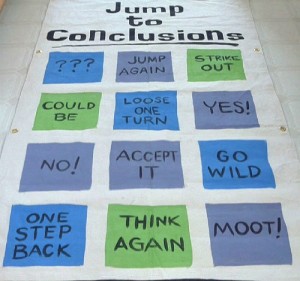 Indeed, my anguish over that email was one of the weirdest parts about the whole experience—I’m ordinarily a pretty calm, Zen guy, but I was in a very strange emotional state by the time I arrived home, and the name on the package made my hair stand on end from the seeming coincidence … yet there was, in fact, as my late-night googling later revealed, objectively no coincidence. I had jumped to a wrong conclusion, but it had triggered a very real emotional response.
Indeed, my anguish over that email was one of the weirdest parts about the whole experience—I’m ordinarily a pretty calm, Zen guy, but I was in a very strange emotional state by the time I arrived home, and the name on the package made my hair stand on end from the seeming coincidence … yet there was, in fact, as my late-night googling later revealed, objectively no coincidence. I had jumped to a wrong conclusion, but it had triggered a very real emotional response.
The simplest explanation for this apparent synchronicity is thus the “retrocausal” one I outlined in my last post as operating in the case of 9/11, the Titanic, Mark Twain’s dream, and the career of Elizabeth Fraser of Cocteau Twins. My awakened anguish over a reminder of my 25-year-old regret over a social blunder echoed backward a few hours to a structurally similar situation, the email at work, and caused an exaggerated emotional reaction that I naturally and logically misattributed to that email. When I got home and found the book and saw who (I mistakenly assumed) it was from, I was blown away by the coincidence: The cosmos seemed to be serving up my guilt to me on a platter. But in fact, it was just serving me an emotional time loop I didn’t immediately fathom until I delved into the matter.
In other words, there was no coincidence, no synchronicity. There was however an “acausal connecting principle” in the form of my powerful and conflicted emotional response: reawakened pain and regret coupled with a kind of excitement—a powerful emotional melange I have called, using Lacan’s term, jouissance.
Synchrosplaining and Psi-sploitation
The exact same process explains Jung’s scarab story. To see why, we need to return the scarab to its proper owner.
It is sort of natural to read the uncanny account as centering on Jung himself—it is implicitly “his” synchronicity because, well, he wrote about it, and it involves simultaneously hearing his patient’s dream story about a scarab and responding to the tapping of an actual scarab at his office window and catching it. Even though it is outside his direct control, Jung thus manages to claim and capitalize on the moment, offering the beetle to his patient (just as she had dreamed) at the precise moment she needs this gesture to break her from her rigid causal modes of thinking. Claiming this moment as a therapeutic intervention, Jung thereby presents himself as a kind of heroic modern shaman or psychomagician.
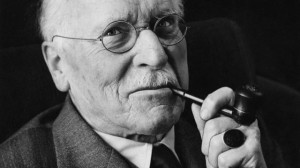 Looking at it this way, as centered on Jung, the event truly would have to be “acausal,” as there is no way to causally explain the coincidence of hearing someone else’s story about a scarab and a real scarab happening to appear at that precise moment. But the simplest explanation is really that it’s not about Jung or his experience at all: His female patient had precognitively dreamed about the scarab, associating it with her impending therapeutic epiphany. Instead of being “Jung’s synchronicity,” a far simpler explanation is that it was his patient’s precognitive dream, and he played merely a supporting, not starring, role in it.
Looking at it this way, as centered on Jung, the event truly would have to be “acausal,” as there is no way to causally explain the coincidence of hearing someone else’s story about a scarab and a real scarab happening to appear at that precise moment. But the simplest explanation is really that it’s not about Jung or his experience at all: His female patient had precognitively dreamed about the scarab, associating it with her impending therapeutic epiphany. Instead of being “Jung’s synchronicity,” a far simpler explanation is that it was his patient’s precognitive dream, and he played merely a supporting, not starring, role in it.
Jung’s spinning of this event, which is dare I say ‘archetypal’ in the lore of the paranormal, as “synchronicity” (as opposed to merely an interesting case of ESP) reflects typical male egotism on his part—appropriating his female patient’s remarkable psi experience and turning it into something much bigger and more profound, something flattering to his (male) genius, because only he is able to grasp and explain it. Jung exploited his patient’s psi, in other words, to support his own nascent theory about how the the inner and outer worlds are linked via his pet concept of archetypes.
Jung’s overreach here may reflect a larger blindness that we all share—not only a temporal bias but also an egotistic bias: our natural habit of interpreting coincidence as the big universe harmonizing with our own little life story. The cosmos winking at us, giving us the thumbs up (or thumbs down, in my case), or at least taking an active interest in us, is a much more ego-gratifying interpretation than the notion that psi is just a natural function that operates all the time in our lives and that produces weird effects because we don’t recognize it. It would be like not believing in farts and instead concocting an elaborate theory to explain those funny smells that every so often waft through the room.
Paradoxically, it is often our ego that prevents us from including the knower in the known … although in the case of the synchronistic scarab, the knower was Jung’s patient, not Jung.
Prophetic Jouissance
There is a recursive, self-similar or self-referential quality about many meaningful coincidences and premonitory or precognitive dreams. In Jung’s case, the scarab happened to be a symbol of rebirth and awakening, so within his (or really, his patient’s) archetypal encounter was an archetype about awakening to archetypes. In my case, the book on my doorstep happened to be about insoluble paradox and contradiction as a creative force, and this fractally rhymed with the very idea that I had been writing about and that I am further developing here: the seemingly paradoxical or self-contradictory notion of time loops as an unconscious factor in thought, emotion, and dreams.
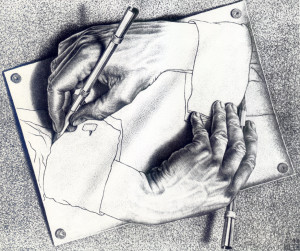 While I think Jung’s theory—that meaningful coincidences reflect an archetypal harmonization of objective events with our unconscious minds—could be an overreach, I do think perceived coincidence does play a crucial role. Because life is a “blooming buzzing confusion” of events and information, coincidences happen all the time and we only notice a fraction of them. Noticing coincidences is facilitated by believing they are significant. On an unconscious level, we probably all believe that; even Richard Dawkins must possess a superstitious unconscious. When we notice objective events that seem to reflect some inner thought, however trivial, this may amplify our reaction to whatever precipitated that thought, doubly so if we happen to derive intellectual or egotistical enjoyment from things paranormal and psychic and synchronistic. The ultimate effect of this enhanced enjoyment of coincidence may be a kind of feedback loop, in which the intensity of our emotional reaction quickly escalates, like a microphone placed too close to a speaker.
While I think Jung’s theory—that meaningful coincidences reflect an archetypal harmonization of objective events with our unconscious minds—could be an overreach, I do think perceived coincidence does play a crucial role. Because life is a “blooming buzzing confusion” of events and information, coincidences happen all the time and we only notice a fraction of them. Noticing coincidences is facilitated by believing they are significant. On an unconscious level, we probably all believe that; even Richard Dawkins must possess a superstitious unconscious. When we notice objective events that seem to reflect some inner thought, however trivial, this may amplify our reaction to whatever precipitated that thought, doubly so if we happen to derive intellectual or egotistical enjoyment from things paranormal and psychic and synchronistic. The ultimate effect of this enhanced enjoyment of coincidence may be a kind of feedback loop, in which the intensity of our emotional reaction quickly escalates, like a microphone placed too close to a speaker.
This is what I meant in my previous post when I suggested that not only was Elizabeth Fraser channeling a presentiment of Jeff Buckley’s drowning death, but that the eventual recognition of the coincidence between her “siren” personal myth and that tragic event actually amplified its traumatic signal into the past, increasing its ‘gain.’ Fraser’s unconscious mind would have enjoyed the (consciously unspeakable, not to mention unrealistic) idea that her siren powers had actually been potent enough to lure an ex-lover to a watery grave, and this amplified the trauma’s uncanny shock, creating a very loud signal that she channeled into exquisitely beautiful music for two decades … in turn boosting the volume of the coincidence on learning of Buckley’s death, in turn intensifying the whole siren thing, and so on… This amplification of jouissance through the paradoxical effect of the time loop is what Lacanians call a “symptom.”
The same thing would have happened with Jung’s patient. Her therapeutic epiphany was a powerful, dreamworthy moment, but its dreamworthiness was boosted by the appearance of the scarab, which became the nucleus of her dream, and thus created the uncanniness when she related the dream to her doctor. The moment in Jung’s office was overdetermined because its signal had been amplified into the past. (Indeed there is maybe no better example of a Lacanian ‘symptom caused by its cure’ than this Jungian incident.) This shows clearly that a time loop may not only be self-canceling, as in the famous grandfather paradox … it could also be self-amplifying.
A time loop may not only be self-canceling, as in the famous grandfather paradox … it could also be self-amplifying.
In my Psi of Regret post I touched on some of the existential and moral ambivalence that prophecy automatically awakens and that acts as a mitigating force on our psychic potential. I think the prophetic jouissance I am describing here is possibly the most powerful and decisive factor—one that paradoxically amplifies precognitive effects at the same time as it pushes them outside of our purview, into the ego-saving and ego-gratifying realm of the “synchronistic,” where they are simultaneously more sublime and less practically useful. Synchronicity may thus be a concept that actually neutralizes our psi by keeping us from too closely examining its disavowed libidinal logic. Jung may have broken from Freud too soon.
In his TED talk, Jacques Vallee invokes Philippe Guillemant’s theory of “double causality” to explain synchronicities: Our intentions cause effects in the future that become the future causes of present effects. I am suggesting the operative term may not be intentions but enjoyment. The time-loop character may be precisely an amplifier of the enjoyment component in trauma that echoes backward in time (or that is simply non-obedient to time), as in disasters and deaths. Some part of us derives a benefit, experiences bliss, at whatever happens—even awful things. A wicked, suppressed, repressed part of us likes to think of ourselves as witches and shamans controlling larger cosmic and magical forces; this disavowed magical-thinking inner savage might actually be a synchromystic trickster in our lives, but perhaps also (if properly propitiated) an ally.
The concept of synchronicity, in other words, may be precisely a conceptual box to defend ourselves from the truth of our precognitive functioning, and thus it may be time to replace it with a better theoretical framework. The concept of jouissance as an atemporal and nonlocal phenomenon could not only help us understand precognitive and other psi effects better, it could also reveal new ways of capitalizing on forces that, for now, for most of us, remain very much in the dark or (apparently) outside our control.
I’ll develop this idea further in future posts.
Trauma Displaced in Time: Premonition, Synchronicity, and Enjoyment

On the morning of September 11, 2001, my alarm awoke me around 6:30AM and I did what I always try to do before dragging myself from bed: I rolled over, grabbed my notebook and pen, and jotted notes on whatever dream images I could recall from the night before. That morning I noted dreaming about driving past a pair of identical “mosques”—distinctly low, 1-story buildings, perfectly square in plan, with drab corduroy-like facades—on a street near where I grew up in Lakewood, Colorado. They were in exactly the site of an office building where, in real life (and about 30 years earlier) my father had briefly had his psychology practice, before moving his office to a nearby bank building.
I had never dreamed of “mosques” before, nor anything with Islamic overtones that I could recall. Islam was not on my radar. The only detail whose meaning I grasped at the time was the one-story-ness of the buildings (i.e., the opposite of tall buildings); my dreams have periodically featured “low buildings” as well as ruined towers that, I had figured out from a decade or more of psychoanalytic dream interpretation, mainly had a standard “castration” symbolism—stereotypical Freudian stuff, and not very remarkable. It was only in hindsight that I realized how the corduroy appearance of my dream “mosques” matched the distinctive corrugated facade of the towers that came crashing down that day.
I’m hardly the only person to have dreamed of something plausibly connected to 9/11 in the days before the event. A quick internet search turns up numerous pages of more remarkable stories of vivid dreams and visions. Bonnie McEneaney, who lost her husband in the attack, recalls in her book Messages that her husband had been gripped for months by a certainty that an attack was imminent and that he was soon to die. And 9/11 ‘prophecies’ go well beyond such narratives that are necessarily biased by hindsight (and thus fail all scientific standards of reliability). The number of ominous-seeming prophetic artworks, images, etc. unmistakeably produced prior to the 9/11 attacks but seeming to depict them is rather staggering, as a quick Internet search also reveals.
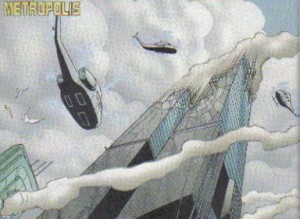 For example, issue #596 of The Adventures of Superman, released on September 12, 2001 (but obviously drawn and written sometime in the weeks immediately preceding the disaster), shows the towers smoldering after being attacked in a superhero conflict. The issue was promptly recalled by the publisher, DC Comics, making it now something of a collectors item. Even more uncanny is the bronze 1999 sculpture Tar Baby vs St. Sebastian by Michael Richards (below), in which the artist depicts himself as one of the Tuskegee Airmen, standing very erect (and building-like), being pierced by numerous planes. Could it have been inspired by a premonitory dream or vision of his own death in his studio on the 92nd floor of Tower One on 9/11?
For example, issue #596 of The Adventures of Superman, released on September 12, 2001 (but obviously drawn and written sometime in the weeks immediately preceding the disaster), shows the towers smoldering after being attacked in a superhero conflict. The issue was promptly recalled by the publisher, DC Comics, making it now something of a collectors item. Even more uncanny is the bronze 1999 sculpture Tar Baby vs St. Sebastian by Michael Richards (below), in which the artist depicts himself as one of the Tuskegee Airmen, standing very erect (and building-like), being pierced by numerous planes. Could it have been inspired by a premonitory dream or vision of his own death in his studio on the 92nd floor of Tower One on 9/11?
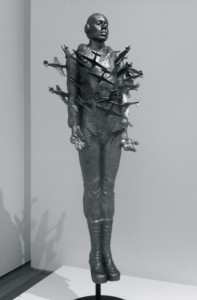 Any man who was a kid in the 1970s may also have been reminded, as the disaster unfolded that morning, of Dino DeLaurentis’s 1976 remake of King Kong, in which the giant ape scaled the then-new twin towers (instead of the Empire State Building) because they reminded him of a pair of rocks he had loved to climb back home on Skull Island. Sci-fi artist John Berkey’s publicity poster for that movie (bottom of this post), with its exploding planes, is eerie in hindsight—as are countless other images in ads, cartoons, or films showing the towers being attacked by or simply standing in ominous juxtaposition to aircraft, and these have of course fueled conspiracy theories about US government foreknowledge of (or involvement in) the attacks.
Any man who was a kid in the 1970s may also have been reminded, as the disaster unfolded that morning, of Dino DeLaurentis’s 1976 remake of King Kong, in which the giant ape scaled the then-new twin towers (instead of the Empire State Building) because they reminded him of a pair of rocks he had loved to climb back home on Skull Island. Sci-fi artist John Berkey’s publicity poster for that movie (bottom of this post), with its exploding planes, is eerie in hindsight—as are countless other images in ads, cartoons, or films showing the towers being attacked by or simply standing in ominous juxtaposition to aircraft, and these have of course fueled conspiracy theories about US government foreknowledge of (or involvement in) the attacks.
Perhaps the most amazing portent of the attacks, though—for me anyway—was Phillipe Petit’s tightrope walk between the still unfinished towers in 1974, as depicted in the documentary Man on Wire. As when the towers fell 27 years later, witnesses on the ground were shocked, awed, thrilled, and terrified, watching this French daredevil blithely balance on a cable 1,350 feet in the air that he had strung between the towers with the help of a bow-and-arrow and a couple accomplices. It is amazing to me, because it is as if the 27-year lifespan of the World Trade Center, that audacious symbol of American power and capitalism, was book-ended or framed by two highly symmetrical events: audacious aerial conquests, both pulled off with great stealth and ingenuity by foreigners who had trained extensively and in secret, for months, astonishing and frightening the crowds below who couldn’t believe their eyes.
A Night to Misremember
Skeptic Martin Gardner would probably have called any attempt to sift the “impossible” from the merely slightly improbable in the long list of “9/11 prophecies” misguided. In a book on the similarly uncanny predictions of the Titanic disaster, he writes that such problems are “not well formed”: “There is no way to estimate, even crudely, the relevant probabilities.” With the Titanic, as with 9/11, there were dreams and premonitions—or at least ones recollected after the fact. For example, in an excellent 1982 In Search Of episode, an elderly survivor, Eva Hart, who had been seven at the time, recalled that her mother had had a terrible premonition that their voyage would be fatal. Hart’s father indeed was lost with most of the other men aboard the ship, although she and her mother made it into to the lifeboats. Gardner lists other similar examples in his book.
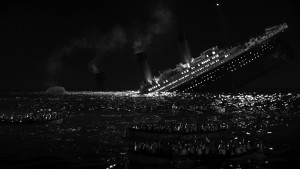 But the most famous prophecy of the Titanic’s sinking—and Gardner’s main focus—is Morgan Robertson’s 1898 novel Futility, or The Wreck of the Titan, which appears to have foretold the disaster down to myriad “impossible” details, including not only the ship’s name (Titan), its tonnage and size, its passenger capacity, its insufficient lifeboats, the iceberg that hit it and where on the ship it struck, the exact location in the Atlantic where it sank, and even the month (April). These details seem amazing when presented in isolation, but Gardner shows that when you put them in context, some of the uncanniness dwindles. The Titanic’s name could have been pretty accurately predicted based on the names of the company’s other ships, for example. Fear of fatally hitting icebergs in the North Atlantic was a very real one at the time, and this would have been natural fodder for a writer of sea yarns. They typically occurred in spring, so April was a natural month to choose. And the idea of too-few lifeboats on a doomed ocean liner was also a pretty natural idea, and was widely used by other writers.
But the most famous prophecy of the Titanic’s sinking—and Gardner’s main focus—is Morgan Robertson’s 1898 novel Futility, or The Wreck of the Titan, which appears to have foretold the disaster down to myriad “impossible” details, including not only the ship’s name (Titan), its tonnage and size, its passenger capacity, its insufficient lifeboats, the iceberg that hit it and where on the ship it struck, the exact location in the Atlantic where it sank, and even the month (April). These details seem amazing when presented in isolation, but Gardner shows that when you put them in context, some of the uncanniness dwindles. The Titanic’s name could have been pretty accurately predicted based on the names of the company’s other ships, for example. Fear of fatally hitting icebergs in the North Atlantic was a very real one at the time, and this would have been natural fodder for a writer of sea yarns. They typically occurred in spring, so April was a natural month to choose. And the idea of too-few lifeboats on a doomed ocean liner was also a pretty natural idea, and was widely used by other writers.
In his book The Sublime Object of Ideology, Lacanian philosopher Slavoj Žižek takes this argument one step further. He notes that the disaster corresponded closely to the political-economic-cultural unconscious of the time, and for this reason took on an a weight of symbolic overdetermination that caused it to appear synchronistic in hindsight. Not only was the ship itself easy to predict in its dimensions and even its name, but some disaster or comeuppance befalling the blithe elite was also easy to anticipate. Žižek writes, “even before it actually happened, there was already a place opened, reserved for it in fantasy space. It had such a terrific impact on the ’social imaginary’ by virtue of the fact that it was expected.” In other words, if it hadn’t been the Titanic sinking, it could easily have been something else. And if Robertson’s novel hadn’t predicted it, it could have been some other novel.
Žižek is suggesting that we would not have been nearly as obsessed with “the Titanic” now or even, arguably, right afterward, had it not been for how uncomfortably closely it happened to match a zeitgeist, the mood of the ending of an era of peaceful progress and stable class distinctions that preceded it. Indeed it was this coincidence—not just with Robertson’s novel but with the whole mood of the times—that actually made it such a trauma, not the other way around, and this is why so much ink has been spilled to interpret and find meaning in it. People incessantly examined the disaster to explain how the “unthinkable” could have happened, and in the process, inevitably turned up a coincidence that looks truly uncanny in in hindsight. Žižek would say the “coincidence” is really a kind of perspective mistake: allowing the retroactive rearranging of symbolic meanings to influence how we perceive the ordinary march of causality.
When we place 9/11 in context, too, some of its coincidences seem less uncanny. The size, stature, and indeed audacity of the towers invited fantasies of audacious conquest, which could readily be expected to be expressed not only in actual real-life terror attacks but also in comic books, disaster movies, and acrobatic stunts. Indeed, terrorists had already attempted to destroy them, which surely planted the seeds of the idea in the collective unconscious as well as in the minds of those who worked in the towers.
But at a certain point—although admittedly that point is fuzzy—the parsimony of the skeptical explanations dwindles relative to the “paranormal” explanation. No amount of evidence for this will sway a hardened skeptic, but abundant evidence for precognition, premonition, and precognitive dreaming exists in parapsychology research. If we are willing to accept any of it as valid, then it means any explanation or account of 9/11 that fails to take into account how such a monumentally traumatic event may have been at least unconsciously foreseen—not by “the government” but by ordinary people, and expressed in their dreams and creative artworks—would actually be inadequate and distorted.
Synchronistic Bias?
The great dream interpreter of the 20th century was of course Freud. His legacy, psychoanalysis, is often thought of as the rule of the present by the past (or as director P.T. Anderson puts it in his Fortean film Magnolia: “We might be through with the past, but the past ain’t through with us”). But that’s not completely true in Freud and even less true in some of his followers. The past is always given its meaning in the present, and so the influence of the past always changes. As events inscribe themselves in our ongoing refashioning of memory, we constantly rearrange the past and give it new symbolic shape. Memory readily selects from its infinite storehouse of associations those that match true events, and produce what can look in retrospect like “impossible” coincidences or the inexorable workings of fate. Since we tend to remember events that are significant to us, it produces what might be called a synchronistic bias to our perception.
If we are going to defend a truly synchronistic or paranormal argument for prophetic dreams, visions, and artworks, we need to confront this psychoanalytic argument: that the associative architecture of memory itself is an “acausal connecting principle,” and that what we live as open-ended in the present can in hindsight look deterministic—even uncannily so—when it is not.
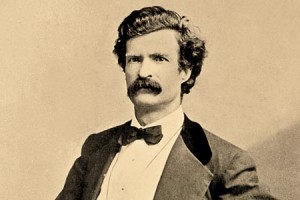 An example of this could be Mark Twain’s precognitive dream about his brother Henry’s death, which Jeffrey Kripal describes in his recent book Comparing Religions
An example of this could be Mark Twain’s precognitive dream about his brother Henry’s death, which Jeffrey Kripal describes in his recent book Comparing Religions. Twain reported that in 1858 he had a dream of his brother lying in a metal casket in a suit of his own clothes and with a bouquet on his chest; a few weeks after this dream, Twain wrote, he received news that Henry had been injured in a boiler explosion aboard the steamboat they were both working on; Henry later died of an overdose of morphine given to kill his pain. In the morgue, Twain beheld the exact scene from his dream, including the clothes and the exact bouquet. It sounds uncanny, but in a series of posts on his very interesting blog, Journal of a UFO Investigator, religion scholar David Halperin does some keen Freudian literary forensics to reexamine the story, putting it back in context and bringing in some very telling clues from Twain’s fictional works about the conflicted feelings the writer held for his more upstanding, “goody-goody” brother.
Halperin deduces from evidence of intense brotherly resentment in Twain’s fiction that he would have had a lifelong unconscious death wish for Henry, and thus would probably have had many dreams, over the years, about him dying. It thus (according to Halperin’s reasoning) might not actually be too strange a coincidence for Twain, upon seeing his brother in a coffin after an unfortunate boiler accident on a Mississippi River steamboat, to recall having dreamed approximately the same thing and formed the notion that he had had a premonitory dream about it. It is significant, Halperin suggests, that Twain never wrote his dream down until 1906, giving his memory ample time—almost half a century—to sort and rearrange events into a more seamless narrative of psychic connection … and brotherly love. Halperin might have added that Twain’s retrospective interpretation at that late date would have fit well with the then-recent theories of psychical research pioneer Frederic W.H. Myers, that trauma is the energy fueling psychic phenomena like telepathy and, perhaps, premonitory dreams.
Psychoanalysis has always provided a halfway house for people who on one hand share Hamlet’s humanistic sense that there are more things in heaven and earth than are dreamt of in reductive materialistic philosophy but who are nevertheless a bit afraid of the truly supernatural—or what we would now call paranormal—alternative: a universe in which things like ESP and ghosts really exist, and in which the mind can know the future or interact with matter in some mysteriously occult fashion. It’s a halfway house I myself have lived in most of my adult life. Halperin himself admits to precisely this ambivalence in another blog post on Robertson’s novelistic ‘prediction’ of the Titanic disaster: “I don’t want to believe in precognition,” he writes; “The philosophical implications are too daunting.”
But being biased against belief makes us no more clear-headed about the issues involved than wanting to believe. At what point does resolute skepticism force us to accept explanations that are actually more convoluted than what really appears to be going on, however “impossible”—that information, or emotion, is just ‘simply’ traveling backward in time from a monumentally upsetting/traumatic event? Even Twain’s dream, which is easily given a more or less mundane psychoanalytic explanation when taken in isolation, appears far more plausibly premonitory when placed alongside the countless similar examples through the history of dream recording and psychical research—mountains and mountains of cases, all fitting a fairly specific pattern of traumatic events sending shock waves through space and time via some sort of psychic ether.
We Are All Murderers
In his Freudian flight from precognition, Halperin hits on something crucial, I think, about the case of Twain’s dream, which I think applies to the dreams and prophecies of the Titanic and 9/11 too, and which also points to an interesting new way of thinking about the intersection of psychoanalysis and parapsychology and the paranormal dimensions of trauma.
He points out that, far from welcoming the reality of Henry’s accidental death on the Mississippi, Twain would have reacted with guilt. That’s the normal reaction when a person finds that dark wishes they had casually or unconsciously harbored have (impossibly) come true. This is because in our irrational, superstitious unconscious minds, we feel responsible for actually causing the calamities we’ve dimly thought of or wished for.
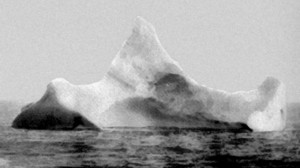 Žižek could have keyed in on the role played by guilt in the Titanic story too: The trauma of the Titanic was not merely the fact that everyone had been expecting some spectacular disaster to befall the rich and then were shocked when it happened; the trauma was that they had actually been wishing for such a disaster—in exactly the same way Twain may have vaguely or unconsciously wished for his brother’s death. Indeed many who saw the front page of The New York Times on April 15, 1912 must have felt on some very dim unconscious nonrational level that their wishes/desires had actually somehow caused the iceberg to sink the ship—it’s just the way the unconscious mind (which is itself like the huge dangerous submerged portion of an iceberg) works.
Žižek could have keyed in on the role played by guilt in the Titanic story too: The trauma of the Titanic was not merely the fact that everyone had been expecting some spectacular disaster to befall the rich and then were shocked when it happened; the trauma was that they had actually been wishing for such a disaster—in exactly the same way Twain may have vaguely or unconsciously wished for his brother’s death. Indeed many who saw the front page of The New York Times on April 15, 1912 must have felt on some very dim unconscious nonrational level that their wishes/desires had actually somehow caused the iceberg to sink the ship—it’s just the way the unconscious mind (which is itself like the huge dangerous submerged portion of an iceberg) works.
It is a psychoanalytic commonplace that, in our unconscious, we are all murderers. When real events accidentally fulfill our unconscious wishes—serve them up to us on a platter—people react with weird conflicting emotions they can’t fully acknowledge or process. News of the Titanic’s sinking would have produced in people not directly touched by the tragedy an unbearable and even unspeakable mix of contradictory emotions that included shock, horror, and sympathy, but also fascination and excitement, as well as a vague guilt for (unconsciously at least) having harbored murderous class resentments focused on the cosmopolitan elite they read about in The New York Times’ society pages. They would have thus “enjoyed” the news—eagerly read the story and talked about it, feeling a complex mix of weird fascination and excitement and guilt as well as horror.
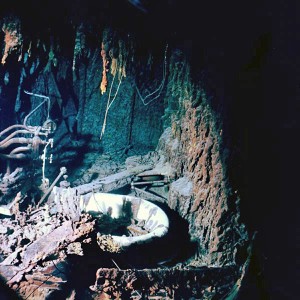 What we particularly fear to see is a “body” that reminds us of our guilty enjoyment. Thus when the Titanic’s remains were finally discovered by Robert Ballard’s undersea cameras in the early 1980s, National Geographic readers gazed on the shadowy photos with a spooked fascination or even a kind of vertigo. Žižek wrote that, “By looking at the [Titanic] wreck we gain an insight into the forbidden domain, into a space that should be left unseen: visible fragments are a kind of coagulated remnant of the liquid flux of jouissance, a kind of petrified forest of enjoyment.”
What we particularly fear to see is a “body” that reminds us of our guilty enjoyment. Thus when the Titanic’s remains were finally discovered by Robert Ballard’s undersea cameras in the early 1980s, National Geographic readers gazed on the shadowy photos with a spooked fascination or even a kind of vertigo. Žižek wrote that, “By looking at the [Titanic] wreck we gain an insight into the forbidden domain, into a space that should be left unseen: visible fragments are a kind of coagulated remnant of the liquid flux of jouissance, a kind of petrified forest of enjoyment.”
9/11 reflects this same phenomenon, of course. For Americans who did not live in Manhattan or work at the Pentagon and who didn’t actually lose loved ones or friends in the attacks, the objective horror of the deaths and destruction and the feeling of national vulnerability were not the sole source of the trauma; the trauma included an added, unspeakable dimension: the contradiction between these aversive facts and our own guilty enjoyment of the cinematic spectacle, our awe at its audacity, and the incredibly warm, positive collective emotions we all shared in days following. This unspeakable enjoyment, not “the thing itself,” explains our collective obsession, re-watching the planes crashing into the towers again and again and again, dwelling endlessly on images of the towers’ wreckage in the poisonous haze, re-living and commemorating that day in our imaginations and our words.
Just as the Titanic fell conveniently into a fantasy space that history had prepared for it, 9/11 fell into a fantasy space that had been prepared for it by decades of disaster cinema and growing social antagonisms. No matter what side of the political fence you were on, it gave everyone mission and meaning—either to go and teach the Muslim world a lesson or to stand up for human rights and intercultural tolerance in a time when our country’s core values seemed in danger of evaporating. 9/11 made us all feel important, and it temporarily gave us back our national pride and unity.
Frederic Myers thought trauma was the energy underlying psychic connections between people, an argument developed by Kripal: “strong emotion (pathos), particularly around trauma and death, is the most common catalyst of robust paranormal events. Trauma, it seems, is what ‘electrifies,’ ‘zaps,’ or ‘magnetizes,’ and hence empowers the imagination. Trauma is the technology of telepathy.” I want to suggest, though, that “trauma” doesn’t quite capture what it was that may have echoed back through time, feeding people’s dreams and premonitions and artworks in the days, months, and decades prior to 9/11/2001 (or prior to April 14, 1912); it was rather the unacceptable mix of horror, guilt, giddy excitement, and awe—the way we derive enjoyment from tragedy, which cannot be consciously acknowledged—that carried that psi signal. Lacanian psychoanalysis calls it jouissance.
No Known Outside the Known
There is no equivalent word in English that captures the pleasurable-painful horror-in-bliss (or blissful horror) of jouissance—it is usually translated simply as enjoyment—but it is one of the core concepts in Lacanian psychoanalysis. Symptoms had been understood by Freud to be a way of “working through” or exorcising the pain of traumatic events or thoughts via repetition, but Lacan reversed this conception: Symptoms are actually the way we reorganize our life in order to continue to derive a secret enjoyment from something that consciously causes us suffering, pain, or revulsion. Symptoms are repetitious, ritualistic acts that attempt to manage this contradiction. The warp of our imaginary-symbolic spacetime produced by this contradiction, and our inability to be rid of our jouissance, something that is always “glued to our heel” (as Lacan put it), is what causes the strange tail-chasing, repetitive “orbiting” behavior of all neurotic symptoms. Could it also account for the spacetime distortions seen in precognitive and premonitory phenomena?
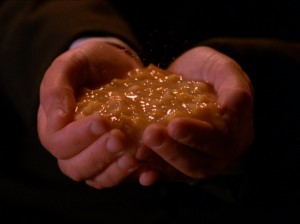 Jouissance, the secret painful enjoyment at the dark heart of our symptoms, is the “only substance acknowledged by psychoanalysis,” according to Žižek. Because it exists beyond symbolism and imagination, this unspeakable enjoyment belongs to the domain that Lacan called the Real—basically, the unknown and unknowable. Its unknowability accounts for the way we have trouble localizing it, either in ourselves (where we don’t quite want it) or in others who are presumed to have stolen it from us (the basic fantasy at the root of racism and sexism). The farther away we imagine “our” lost enjoyment, the bigger it seems to be, almost like the “dolly zoom” special effect used in Hitchcock’s Vertigo.
Jouissance, the secret painful enjoyment at the dark heart of our symptoms, is the “only substance acknowledged by psychoanalysis,” according to Žižek. Because it exists beyond symbolism and imagination, this unspeakable enjoyment belongs to the domain that Lacan called the Real—basically, the unknown and unknowable. Its unknowability accounts for the way we have trouble localizing it, either in ourselves (where we don’t quite want it) or in others who are presumed to have stolen it from us (the basic fantasy at the root of racism and sexism). The farther away we imagine “our” lost enjoyment, the bigger it seems to be, almost like the “dolly zoom” special effect used in Hitchcock’s Vertigo.
The fact that enjoyment belongs to the radically unknown space of the Real contains potentially interesting implications for parapsychology. Because enjoyment exists suspended in a protected or bottled state of unknowability (the symptom that preserves our proximity and distance), it is like the wave function in Quantum physics: It cannot be subjected to measure and differentiation and localization. It is literally “nonlocal” in both time and space. The symptom is thus an atemporal, acausal construct that defies rational analysis because its meaning-cause—its reason for being, as explained in words—lies always somewhere off in the future.
Žižek has described at length in his books how jouissance plays a sort of acausal role in our symptoms; he has always invoked science fiction stories (and Wagner’s Parsifal—see my “Passion of Einstein” post) to illustrate how psychoanalytic symptoms are actually caused by a future event that also cures them, through a kind of “time-loop” logic. Careful to avoid any hint of paranormal thinking or the dreaded “New Age obscurantism,” he is cautious to specify that he is referring to the retroactive reordering of the symbolic universe discussed previously: the way meaning only exists in the present configuration of symbols and signifiers, which are constantly being reshuffled and transformed (in other words, the past that the present affects is simply the known past, the past as it appears in hindsight through the symbolically structured filters or overlay of our perception and memory).
But this strikes me as a defense mechanism of a briliiant materialist whose brilliance has led him—oops—to discover the insufficiency of material causation. Because consider: There is no known outside the known. Once you grant that enjoyment exists outside the known, in the domain of the Real, you cannot then specify that it has any knowable properties—such as only existing here and now and not anyplace else, or traveling in only one temporal direction. (You can’t even exactly say what emotion it corresponds to—it’s sort of all of them, and none.)
So, what if we take literally, rather than figuratively, the idea that enjoyment is radically outside of knowability and locality? Could enjoyment, particularly when it is bottled in a symptom, be a kind of nonlocal medium that not only connects people across space (telepathy) but also connects people to themselves through time?
Remember: As J.W. Dunne noted in his An Experiment With Time, precognitive or premonitory dreams aren’t about future events, they are about one’s own learning of those events. What I’m proposing builds on this assumption: It may not be traumatic events per se that reverberate through the psychic ether, but rather our own ‘jouissant’ reaction to learning of those events. It is this reaction, which we have no way of consciously understanding, that gets turned into premonitory dreams and art.
Eating From the Same Plate
Throughout his books, Žižek likens enjoyment (the one and only substance) to the identical green mush eaten by the separate diners at a chic restaurant in the movie Brazil, each of whom has their own unique picture of what their meal should be standing over identical formless lumps the plates. The idea is that enjoyment is all the same, there’s only one enjoyment, even though we all perceive it differently, within different symbolic and imaginary frames, and thus have a difficult or impossible time recognizing that our enjoyment is actually shared. The diners are all eating the same formless enjoyment … but to make the analogy fully correct, fully true to Žižek’s own argument, the diners should all actually be eating from the same plate—for if it is truly unknowable and unmeasurable, this substance of the Real cannot be divided or differentiated or portioned; their “separate plates” are really mirage reflection of a single plate of enjoyment, “one thing.”
 More to the point, if the diners all eat from the same plate, that same plate could be eaten simultaneously by themselves in the past, and future. If we think of jouissance this way, like an ‘out of space and time’ singularity we are all in contact with, it could serve as precisely the “acausal connecting principle” that Jung was looking for in his somewhat muddled concept of synchronicity.
More to the point, if the diners all eat from the same plate, that same plate could be eaten simultaneously by themselves in the past, and future. If we think of jouissance this way, like an ‘out of space and time’ singularity we are all in contact with, it could serve as precisely the “acausal connecting principle” that Jung was looking for in his somewhat muddled concept of synchronicity.
A dream that amazingly comes true, or a premonitory obsession that is verified, or a creative artistic inspiration that is uncannily mirrored in a real future event are all examples of “symptoms” in miniature: Irrational behaviors or thoughts or feelings that find their meaning or “answer” only in some unsettling or traumatic future occurrence. Perhaps it is even precisely our effort to “repress” the unacceptable part of our traumas—that is, to split them and bury the half we don’t want to see (our enjoyment)—that results in acausal, atemporal phenomena like precognitive dreams and premonitions.
Freud wrote of “the return of the repressed,” although it is the concept of repression that has tarnished his reputation most among scientific psychologists: While the unconscious exists, no evidence has ever been found for repression. Supposedly ‘repressed’ memories that are ‘recovered’ in hypnosis or therapy, for instance, are often false or fabulated. Real, verifiable traumas are forgotten and remain inarticulable, hard to put into words because we lacked the necessary concepts at the time they happened, but they are not actively buried by any censoring force in the psyche. A trauma victim usually awakens to the trauma spontaneously at some point, not with the ‘aid’ of discredited methods like hypnosis. But what about the unbearable contradictory feelings that might accompany a trauma? What about the unbearable dimension of enjoyment?
Perhaps repression does exist in some sense, and we have been looking for it in the wrong place. What if our symptoms are able to sequester certain thoughts or feelings, for instance guilty feelings about enjoying something objectively horrible, in a place they really can’t be found—the past? Perhaps it is precisely our repressed jouissance that “returns” in our own past, where we can have no way of understanding its meaning. If something like that is the case, then our present symptoms may contain the “repressed” of our future.
Synchro-causality
 To illustrate on a small scale how temporally displaced repressed jouissance might exert a causal influence on the past via a symptom, let’s consider another uncanny case of “death on the Mississippi.” On his always interesting blog The Secret Sun, Christopher Knowles devoted a series of posts to the synchronistic perfect storm that surrounded the life, loves, and career of Scottish singer Elizabeth Fraser (right), the lead singer of Cocteau Twins (and also one of my favorite musical artists). In the mid-1990s, Fraser entered into an obsessive, intense romance with the singer Jeff Buckley (below), who had just published a wildly critically acclaimed debut album (Grace) revealing an astonishing talent that mirrored that of his father Tim Buckley. The elder Buckley had died young of a drug overdose in 1975 without really ever getting to know his son, and it was hearing Fraser’s haunting cover of his father’s 1970 “Song to the Siren” in 1994 that, according to Knowles, drove Buckley to seek out Fraser, at which point they became intensely involved for a couple of years.
To illustrate on a small scale how temporally displaced repressed jouissance might exert a causal influence on the past via a symptom, let’s consider another uncanny case of “death on the Mississippi.” On his always interesting blog The Secret Sun, Christopher Knowles devoted a series of posts to the synchronistic perfect storm that surrounded the life, loves, and career of Scottish singer Elizabeth Fraser (right), the lead singer of Cocteau Twins (and also one of my favorite musical artists). In the mid-1990s, Fraser entered into an obsessive, intense romance with the singer Jeff Buckley (below), who had just published a wildly critically acclaimed debut album (Grace) revealing an astonishing talent that mirrored that of his father Tim Buckley. The elder Buckley had died young of a drug overdose in 1975 without really ever getting to know his son, and it was hearing Fraser’s haunting cover of his father’s 1970 “Song to the Siren” in 1994 that, according to Knowles, drove Buckley to seek out Fraser, at which point they became intensely involved for a couple of years.
 Their intense/obsessive relationship was on-again/off-again, and eventually Buckley left Fraser, becoming involved with another woman. It was around this time that he sequestered himself in a rented house in Memphis to write songs for his second album. Just as his musicians were on their way to Memphis to begin recording—literally, while they were in the air—Buckley took an impromptu swim in a tributary of the Mississippi and got caught in the undertow generated by a passing boat. His body was found a couple days later.
Their intense/obsessive relationship was on-again/off-again, and eventually Buckley left Fraser, becoming involved with another woman. It was around this time that he sequestered himself in a rented house in Memphis to write songs for his second album. Just as his musicians were on their way to Memphis to begin recording—literally, while they were in the air—Buckley took an impromptu swim in a tributary of the Mississippi and got caught in the undertow generated by a passing boat. His body was found a couple days later.
The coincidences and premonitions are too numerous to summarize (you should just read Knowles’ posts), but at their core are the fact that Fraser’s entire career seems in hindsight like a protracted achingly beautiful omen of Buckley’s death. She wrote and sang again and again about water, drowning, and sirens luring people to a watery grave (“Lorelei,” “Sea, Swallow Me,” etc.). Indeed her cover of Jeff’s father’s “Song to the Siren” (about being drawn to a siren who rejects her, and whom she then pleads to come be enfolded in her watery arms), for the supergroup This Mortal Coil’s album It’ll End in Tears, is one of her best-known performances. That was indeed a “siren song” in the sense that it summoned Jeff Buckley to her, and in hindsight was just one of many songs (you should also look at Cocteau Twins’ videos and album covers) whose imagery of water and loss seemed to foretell to the disaster to come. Fraser received news of Buckley’s death when in a studio in England recording the song “Teardrop” with the band Massive Attack for their album Mezzanine—another high point in her brilliant career, which largely faded after that point.
Again, there’s no way to measure coincidence. Is this all just a reshuffling and reordering of events in hindsight to construct a “destined” meaning to Jeff Buckley’s death? We can never disprove that, but Knowles does a good job of persuading that something more had to be going on. But if so, what? The standard archetypal, “synchromystic” explanation would be that somehow the “siren” archetype imprinted itself on history via these hapless individuals, who, as Knowles suggests, “were merely acting out roles written for them long before their grandparents were born.”
A skeptic willing to minimally accept that Buckley’s drowning was more than coincidence but that there was nothing paranormal occurring could go the halfway-house psychoanalytic route, offering that Fraser’s siren obsession infected Buckley’s unconscious mind and gave specific form (drowning) to an unconscious death wish, perhaps somehow to follow his father to an early grave. Less boldly, you could also suggest her obsession with water spilled over (so to speak) onto Buckley and simply increased his statistical likelihood (a) of taking spontaneous swims and (b) of perishing in the water. Žižek, for whom the past is constantly being reshuffled and given new meaning within the present Symbolic order, would probably say Buckley’s drowning was like a final psychoanalytic interpretation that “answered” Fraser’s symptom (i.e., her career) and effectively cured her of it. Indeed, as Knowles notes, Fraser has seemed to have lost her otherworldly muse and become, perhaps for better as well as worse, just a normal human being in its aftermath. In all these variants, the apparent synchronicity only appears as such in hindsight.
But if we grant that intense/traumatic enjoyment may operate nonlocally in a person’s life, I would propose that the most parsimonious and even realistic explanation of the coincidences surrounding Fraser and Buckley would be one that takes Žižek’s cautious symptom retrocausality and literalizes it: The death of Fraser’s eventual lover and muse, Jeff Buckley, was a trauma that reverberated backward in time along the resonating string of her creative enjoyment, becoming an inchoate idee fixe that appeared again and again and again in her music. Fraser channeled or drew from this trauma as the source and inspiration for most of her career, without having any way to recognize that it was a terrible future shock that she was feeling, seeing, or channeling.
Enjoyment as a Carrier
“Ready to sing, my sixth sense peacefully placed on my breath,
and listening, my ears know that my eyes are closed”
—Elizabeth Fraser/Massive Attack, “Group Four”
According to Knowles, Fraser claimed in the early 1990s that she had been the victim of sexual abuse as a child. This is possibly significant. Creative people are often “driven” (perhaps not the right word) by a trauma in their past, and I believe it is something of a commonplace in studies of paranormal phenomena that some early trauma (like abuse, or a death of a parent or sibling, or a difficult birth) is often found in people receptive to otherworldly or paranormal events. Also, given what we know about the psychotherapeutic zeitgeist of the 1990s and the tendency to overinterpret or embellish (and in many cases invent, though I’m not suggesting that here) abuse trauma memories, she may even have misrecognized or overemphasized the pain driving her as her past abuse trauma when the trauma was “really” something ahead in the future she had no way of knowing about or believing in. Could her outrageous creative talent have been like a short circuit between the twin traumas bookending her career?
In other words, I am not trying to explain Buckley’s death here: That was, I am proposing (for the sake of argument), “just” an accident. I am trying to explain the retroactive effect his death might have had on a woman’s creativity (and heck, maybe even his own father’s creativity all the way back in 1970 when he wrote “Song to the Siren”). Buckley’s death’s appearance of meaningfulness was the illusory result of his lover’s whole lifetime oeuvre leading up to it; but (and here’s where it becomes ‘paranormal’) that body of work was indeed motivated by, inspired by, that future death and the complex unbearable feelings it would provoke in her, which reverberated into the past, along the atemporal resonating string of her creative jouissance (her “sixth sense … placed on her breath,” as she describes it in the song “Group Four”). (On his blog, Bruce Duensing speculates that fear is a “carrier wave” for paranormal phenomena; I think carrier wave is a great metaphor, so long as we replace “fear” with jouissance.)
 Here’s the thing, though: The shock of Buckley’s death would have been not only the trauma of his loss (she had already lost him effectively, as he had broken up with her), but the way his drowning revealed the “true meaning” of all her songs, the way it perfectly fit or matched the space her own art had repeatedly created for it, effectively confirming, at least on an unconscious level, that she was indeed the otherworldly powerful medium and “siren” that she had always allowed herself to be perceived as. How could her unconscious mind not have felt a terrible glee and awe (as well as guilt) for precisely what Knowles even intimates her siren powers actually might have done, which was channel or focus obscure dark magical forces that perhaps drew Buckley to his doom?
Here’s the thing, though: The shock of Buckley’s death would have been not only the trauma of his loss (she had already lost him effectively, as he had broken up with her), but the way his drowning revealed the “true meaning” of all her songs, the way it perfectly fit or matched the space her own art had repeatedly created for it, effectively confirming, at least on an unconscious level, that she was indeed the otherworldly powerful medium and “siren” that she had always allowed herself to be perceived as. How could her unconscious mind not have felt a terrible glee and awe (as well as guilt) for precisely what Knowles even intimates her siren powers actually might have done, which was channel or focus obscure dark magical forces that perhaps drew Buckley to his doom?
I’m doubtful Fraser’s witch powers actually reached out across the ocean and drew Buckley into the Mississippi, but Fraser’s unconscious mind might have believed precisely that possibility, and this would have added to the trauma, making his death “speak louder” into the past, back along that resonating string (or carrier wave) of her creativity. Her guilty enjoyment would have been her unconscious belief in the power of her own siren song. Her symptom—her music—through its repetition of themes of sirens and drowning, could have boosted the ‘gain’ of the painful guilty enjoyment-signal she was receiving from the future, amplifying the obviousness of the coincidence (and thus the traumatic shock) when she learned that Buckley died and the way he had died.
This is all (wild) speculation, obviously. But I do think the dark complexity of our reactions to traumas, ranging from minor emotional disturbances to personal tragedies to terrorist attacks, could be the key not only to premonitory dreams and like phenomena but also to understanding many apparent synchronicities. Some synchronicities could really be misrecognized precognition of our own guilty enjoyment.
The Solaris Mind: Hypnagogia, Meditation, and Insight
A classic motif in science fiction is that humanity ventures to the farthest reaches of space only to find, impossibly, something of our own that we had forgotten. Stanislaw Lem’s 1961 novel Solaris, about a planet covered by a viscous ocean that manufactures simulacra from its observers’ unconscious, is probably the purest expression of this idea.
The backstory of Lem’s novel is that the planet Solaris captured the interest of its discoverers because of its impossible stable orbit around its double star. Exploration revealed that its ocean somehow, perhaps sentiently, shifted the planet’s center of mass to steer it in its orbit. But even more mysteriously, it generated beautiful sculptural forms, rising high into the atmosphere and then dissolving back into it a few hours or days later. This ocean seemed dimly and inscrutably intelligent, so a station was placed in orbit to observe and study it. After several decades of study, spawning a whole library of inconclusive research and scientific controversy, some of the forms generated by the ocean started to resemble human tools and objects, as though pulled from the memories of the scientists observing it. One scientist reports seeing a giant baby rise above the waves out of the fog, but most of his colleagues think he is crazy.
When the protagonist Kris Kelvin arrives on the station to investigate a suspected breakdown among its small crew, he finds that synthetic people from the scientists’ pasts have started to appear on the station, confronting them with their own darkest desires and painful regrets, driving them to the brink of madness—and one even to suicide. Soon after his arrival, a perfect simulacrum of his ex-wife Rhea, who had committed suicide after he cruelly abandoned her years earlier, appears in his quarters, without any memory of how she got there.
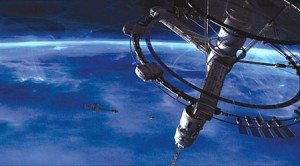 Solaris has been adapted twice for the screen—by Andrei Tarkovsky in 1972 and by Steven Soderberg in 2002. Both adaptations concentrate on the ambivalent romance that develops between Kelvin and his resurrected ex, largely ignoring the planet itself and its mimetic ocean-forms. This is unfortunate (and it disappointed Lem too), because Solaris the planet is one of the most fascinating and awe-inspiring creations in science fiction.
Solaris has been adapted twice for the screen—by Andrei Tarkovsky in 1972 and by Steven Soderberg in 2002. Both adaptations concentrate on the ambivalent romance that develops between Kelvin and his resurrected ex, largely ignoring the planet itself and its mimetic ocean-forms. This is unfortunate (and it disappointed Lem too), because Solaris the planet is one of the most fascinating and awe-inspiring creations in science fiction.
Lem, who died in 2009, remains unsurpassed in his imagining of the possibilities of alien intelligence and human incapability to interpret or understand it. With Solaris, I have no doubt the Polish writer was inspired by the most alien form of our own human intelligence: hypnagogia, the baffling and surreal imagery generated by the unconscious that can be seen clearly on the edge of sleep and in meditative states.
Digesting the Now
Hypnagogic imagery have no doubt inspired art and religion since the dawn of humanity. It was an early scientific observer of hypnagogic phenomena, the psychoanalyst Herbert Silberer, who first noted that these images are often or perhaps always “autosymbolic”—they represent, usually in an astonishingly clever way, some immediate thought or some preoccupation right now, right at the instant they are created. Like dreams, this correspondence to real experience is not immediately obvious but reveals itself readily in free-associative interpretation. I’ve argued elsewhere that dreaming is the punny, playful-associative “art of memory” operative during sleep; hypnagogia is a waking window onto this same process.
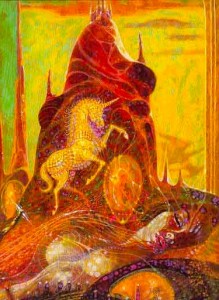 Meditators and yogis have always compared the mind to an ocean, in which thoughts are like waves that trouble the surface. I think the playful, ingenious, autistically inscrutable Solaris ocean is an even better, more nuanced metaphor than any dumb old Earth ocean. The mind is a constant mimetic sea, perpetually generating imaginary representations of everything we encounter and think about and experience; it combines and shapes these ghosts effortlessly into brilliant symbolic tableaux and scenes that brilliantly distill the meaning of “gist” of our experience. Hypnagogia shows us this automatic process, the Solaris mind’s constant metabolism of experience.
Meditators and yogis have always compared the mind to an ocean, in which thoughts are like waves that trouble the surface. I think the playful, ingenious, autistically inscrutable Solaris ocean is an even better, more nuanced metaphor than any dumb old Earth ocean. The mind is a constant mimetic sea, perpetually generating imaginary representations of everything we encounter and think about and experience; it combines and shapes these ghosts effortlessly into brilliant symbolic tableaux and scenes that brilliantly distill the meaning of “gist” of our experience. Hypnagogia shows us this automatic process, the Solaris mind’s constant metabolism of experience.
We ordinarily don’t discern or detect this continual churning out of image-representations because it is so subtle, so in the background. It is only when the foreground stuff of conscious mental chatter and active thinking is quelled or silenced that it becomes apparent. Meditators interested in the phenomenon can learn to stabilize the edge state on the verge of sleep where these forms can be witnessed and recorded. Hypnagogia can be used to access lucid dreams (the “wake-induced lucid dream” or WILD method described by Stephen LaBerge); and many consider the hypnagogic mind to be uniquely receptive to psychic phenomena. (The most comprehensive book on the topic is the wonderful Hypnagogia, by Andreas Mavromatis—highly recommended.)
But the fact that we mainly detect our preconscious image-building on the edge of sleep should not lead us to believe that it only happens then. This function, an aspect of what Sartre and Lacan both called “the Imaginary,” is a constant process, one that is essential to thinking and the associative bundling of experience so that it can feed our memory mill.
Symbolically metabolizing experience by reducing it to cartoon-dioramas firstly creates mental objects that can be fastened with symbolic labels and manipulated in thought, like toys and action figures we move around in our mental sandbox. They are a basic requirement for thinking. And because they are minimally detailed, these cartoon replicas probably maximize the amount of experience that can be fit into the limited workspace of our working memory: We can only keep 4 or 5 discrete “items” in our heads at one time.
The dioramas of the Imaginary thus facilitate the present situation forming a “chord” with immediate past and future experiences, giving thickness and substantiality to the Now. And by reducing experience to something sketch-like, they likely enable more of that experience to get through the working-memory bottleneck to be stored and transferred to long-term memory later on. The reduced, cartoon-like symbolic representation that can be unpacked at the other end, so to speak, through webs of associative linkages, just like dreams (which, I argue, are long-term memories in the process of formation—see below).
“Every thing fits into its own shape”
The Solaris mind’s incessant brilliant mimesis, as crucial as it is for functioning in the world and enabling us to remember our experiences later, is also to blame for the foremost obstructions of spiritual vision: the arising of the idea of self, and with it the constant fading of presence (that is, “being here now”) that has been the bane of meditators and mystics for millennia.
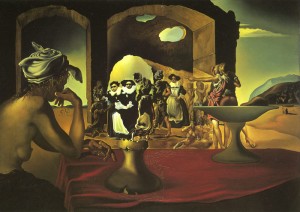 To free us from having to give all our attention to the present moment, the imagination constantly replaces our naked awareness of the world with sketch-like scenes of “I seeing.” You can experience this yourself: Just take a deep breath, exhale, and focus visually on an object in front of you. Initially there is a silent vivid sense of full presence with the object—the object richly and brightly fills your attention—but after just a few seconds the vividness of the object fades slightly as a faint, subtle mental diorama of “me seeing this” emerges in your awareness to compete with it; you might also notice further layers of imagination, like a background meta-awareness of “being seen seeing” (the constant inner haunting presence that Lacan called “the Gaze”). Naked awareness is thus perpetually obscured in consciousness with new virtual ghost-representations—literally, every few seconds, new puppet-subjects and new gazes form, in a slow but incessant pageant of simulacra that represent the self.
To free us from having to give all our attention to the present moment, the imagination constantly replaces our naked awareness of the world with sketch-like scenes of “I seeing.” You can experience this yourself: Just take a deep breath, exhale, and focus visually on an object in front of you. Initially there is a silent vivid sense of full presence with the object—the object richly and brightly fills your attention—but after just a few seconds the vividness of the object fades slightly as a faint, subtle mental diorama of “me seeing this” emerges in your awareness to compete with it; you might also notice further layers of imagination, like a background meta-awareness of “being seen seeing” (the constant inner haunting presence that Lacan called “the Gaze”). Naked awareness is thus perpetually obscured in consciousness with new virtual ghost-representations—literally, every few seconds, new puppet-subjects and new gazes form, in a slow but incessant pageant of simulacra that represent the self.
By “self” I don’t just mean the ego or “I” in the diorama. Every object of perception too, by being copied in the imagination, assumes a virtual ghost presence or double. Whenever our eyes fall on an object, this interplay of the ghost-making Solaris mind and the webs of linguistic symbols we map onto those image-representations produce the sense of recognition, a sense of “what it is,” enabling a labeled image-object to be manipulated in thought. This “what it is,” or itself-ness, the fiction of self-identity, is—when we become attached to it or believe in it—the ultimate stumbling block toward spiritual liberation. Belief in the self is the basic error and even absurdity that, for Buddhists, is the fundamental reason for human suffering.
The reason an object’s self-identity is absurd was explained best, I think, by Ludwig Wittgenstein in his Philosophical Investigations:
“A thing is identical with itself.”—There is no finer example of a useless proposition, which yet is connected with a certain play of the imagination. It is as if in imagination we put a thing into its own shape and saw that it fitted. (We might also say: “Every thing fits into itself.” Or again: “Every thing fits into its own shape.” At the same time we look at a thing and imagine that there was a blank left for it, and that now it fits into it exactly.) Does this spot O “fit” into its white surrounding?—But that is just how it would look if there had been a hole in its place and it then fitted into the hole…
So, in short, the Solaris mind takes the alive Heraclitean flux of experience and constantly copies and fossilizes it in cold dead representational dioramas suitable to be thought about and metabolized in memory. The battle of meditative engagement is with this continuous force of autosymbolic imagining (not just the more obvious verbal chatter). The aim is not to obliterate our mental models of ego and self—we need these illusions to function in the world—but to shift the balance: from living completely in the empty, frustrating world of mental representations (images and words) toward abiding for greater stretches of time in the wordless, imageless, blissful Real that lies beyond and outside them.
The Solaris Mind Produces Teachers
During the day, because its imagery is so yoked to the senses, the Solaris mind generates innocuously realistic images that are hard to detect, because they so closely resemble the “shape” of our lived experience and then are immediately washed away by the thoughts that are seeded from them—like ocean waves erasing a picture drawn in the sand. When liberated from thought and sense, however, as on the edge of sleep or in meditation, these images assume their more wildly imaginative genius.
 The paradoxical effect of withdrawing from the senses and temporarily quelling the flow of verbal and imaginal thought is that it enables daytime hypnagogic images to assume the vivid otherness of full-on waking dreams. These brief visions, flickering out as quickly as they appear, provide “object lessons” that can enlighten and inspire. Famously, artists like Dali have used them for inspiration. August Kekule’s famous “dream” of a snake biting its tail, which gave him the idea of the benzene ring, was actually a waking reverie, a hypnagogic image. When David Lynch
The paradoxical effect of withdrawing from the senses and temporarily quelling the flow of verbal and imaginal thought is that it enables daytime hypnagogic images to assume the vivid otherness of full-on waking dreams. These brief visions, flickering out as quickly as they appear, provide “object lessons” that can enlighten and inspire. Famously, artists like Dali have used them for inspiration. August Kekule’s famous “dream” of a snake biting its tail, which gave him the idea of the benzene ring, was actually a waking reverie, a hypnagogic image. When David Lynch writes of finding his great creative solutions in the period right after dipping into the “unified field” during Transcendental Meditation, hypnagogia is probably what he is referring to.
Buddhist orthodoxy counsels that meditators should ignore these beguiling hypnagogic images (called makyo), but here the ancient and modern masters are quite mistaken, I believe. When properly disciplined and observed with detachment, hypnagogia can be enormously helpful to a personal spiritual path.
 One of my first “kenshos” as a beginning Zen meditator many years ago involved a vivid hypnagogic vision of the exact absurdity addressed by Wittgenstein with his notion of a spot fitting into its own shape. After sitting on the sofa meditating for about 15 minutes, I happened to glance down at my coffee mug, and I saw the curved handle not as something for holding the object but as a tube through which circulated the mug’s “self-ness,” flowing out and back into it, like its secret lifeblood.
One of my first “kenshos” as a beginning Zen meditator many years ago involved a vivid hypnagogic vision of the exact absurdity addressed by Wittgenstein with his notion of a spot fitting into its own shape. After sitting on the sofa meditating for about 15 minutes, I happened to glance down at my coffee mug, and I saw the curved handle not as something for holding the object but as a tube through which circulated the mug’s “self-ness,” flowing out and back into it, like its secret lifeblood.
In a flickering instant, I then grasped that every other object, and even me, would, if we actually had selves, need some kind of tubular circulatory system, like a coffee mug handle, to pump this linguistic fiction out and back in. (I was reminded, among other things, of the surreal scene in Terry Gilliam’s Brazil when the repairman played by Robert DeNiro opens up an apartment HVAC unit and “operates” on the bloody organs inside.) As this absurd idea of the self as an alive vitality inside inert objects vanished, it left in its wake a euphoric clear perception of what the Zen writers call “suchness”—things just as they are without any unnecessary concept like “self” added to them. My ordinary error of believing in things’ inner selfhood seemed delightfully absurd, and I think I grinned rather uncontrollably for a few hours afterward. (This experience, I should add—like countless subsequent ones—was brought on without the use of any substance … well, besides caffeine.)
Catch and Release
In his essay “Negation,” Freud wrote that absence can only reveal itself as the absence of a presence, and a thing has to be asserted before it can be denied. This is possibly one of his keenest insights, with implications well beyond psychotherapy. It is impossible for the mind to represent the non-existence of something; it can only show a thing along with some sign of erasure, such as the thing being destroyed, being taken away, or even being ridiculed or insulted.
In my “coffee mug” example, the Solaris mind was giving me a push. It could not directly represent for me the Zen truth of nothingness or Void or no-self; instead, at the precise moment I needed it, it showed me “self” as a kind of silly cartoon “bodily fluid” and invited me to laugh at the notion.
An active, philosophically engaged meditation practice produces such hypnagogic object-lessons quite frequently, often with the mild euphoria of an “aha” experience, and sometimes much more. In other words, meditation can powerfully open the doors of the brain’s endogenous ‘entheogenic’ capacities.
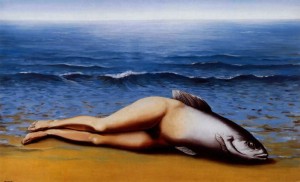 Because these kinds of insights produced by the Solaris mind are so profound and rewarding, the temptation is always to cling to them—and that is the basis of Buddhist teachers’ distrust. You do need to let them happen but let go of them afterward—”capture and release,” a phrase used by the Zen master Lin-Chi (Rinzai), comes to mind. I have found that hypnagogic object lessons have a brief lifespan of effectiveness anyway: They are rich and energizing and clarifying when they occur, and they can be summoned back as reminders for a day or two at most, but then they become “dead” or lose their charge, like they have only a limited battery life.
Because these kinds of insights produced by the Solaris mind are so profound and rewarding, the temptation is always to cling to them—and that is the basis of Buddhist teachers’ distrust. You do need to let them happen but let go of them afterward—”capture and release,” a phrase used by the Zen master Lin-Chi (Rinzai), comes to mind. I have found that hypnagogic object lessons have a brief lifespan of effectiveness anyway: They are rich and energizing and clarifying when they occur, and they can be summoned back as reminders for a day or two at most, but then they become “dead” or lose their charge, like they have only a limited battery life.
Hypnagogic object lessons accessed in meditation or our nightly twilight realm really are very much like the “mimoids” and “symmetriads” and other forms produced on Solaris: emerging out of the ocean, witty, playful, profound, mysterious, and then they break down or dissolve back into it. It is the rule of the oceanic Solaris mind as with anything else: Things arise and then they pass away. And eventually new ones appear, in a neverending cycle.
Living In Orbit
If hypnagogic images are like Solaris’s “mimoids” rising from the seething ocean, hypnagogia’s more solid cousins, dreams, are like the “visitors” that, in Lem’s novel, appear during the night while the scientists on the station are slumbering. The visitors in Solaris are simulacra of people associated with each scientist’s innermost desires or shames, whose company the scientist’s enjoy in an ambivalent, desultory, embarrassed fashion, knowing them to be unreal yet unable to destroy or be rid of them.
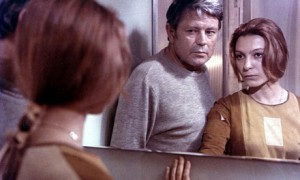 The unconscious depths plumbed somehow by the planet mind and then replicated are whitewashed and sanitized in both of the unfortunately boring film adaptations by otherwise great directors (Tarkovsky, Soderberg). In the novel, Kelvin’s dead wife is the least bizarre and embarrassing of the visitors. One of the scientists, Snow, appears to harbor a child in his quarters (and possibly also a monster) that he won’t let anyone else see, and suggests only that it represents some “uncontrollable thought” that he once had and that has now bound itself to him:
The unconscious depths plumbed somehow by the planet mind and then replicated are whitewashed and sanitized in both of the unfortunately boring film adaptations by otherwise great directors (Tarkovsky, Soderberg). In the novel, Kelvin’s dead wife is the least bizarre and embarrassing of the visitors. One of the scientists, Snow, appears to harbor a child in his quarters (and possibly also a monster) that he won’t let anyone else see, and suggests only that it represents some “uncontrollable thought” that he once had and that has now bound itself to him:
“What is a normal man? A man who has never committed a disgraceful act? Maybe, but has he never had uncontrollable thoughts? Perhaps he hasn’t. But perhaps something, a phantasm, rose up from somewhere within him, ten or thirty years ago, something which he suppressed and then forgot about, which he doesn’t fear since he knows he will never allow it to develop and so lead to any action on his part. And now, suddenly, in broad daylight, he comes across this thing…this thought, embodied, riveted to him, indestructible. He wonders where he is…Do you know where he is?”
“Where?”
“Here,” whispered Snow, “on Solaris.”
Is Snow, in his deep unconscious, a child murderer? A pedophile? Brilliantly, Lem leaves this man’s horrible materialized thought ambiguous. Snow goes on to characterize himself as “a man who at one and the same time is ashamed of the object of his desire and cherishes it above everything else, a man who is ready to sacrifice his life for his love, since the feeling he has for it is perhaps just as overwhelming as Romeo’s feeling for Juliet.”
Whatever Snow’s secret desire is, one could not ask for a better literary representation of the Real as described by Lacan: “a thought, embodied, riveted to him, indestructible.” The Real is unrepresentable and unspeakable, and it is associated with the furtive, fatal, inexplicable compulsions “beyond pleasure” that sustain us and on some deep level give meaning to our lives, even though we may have little conscious awareness of them. It is also the deepest secret buried deep in our dreams.
…Soll Ich Werden
Dreams, as I said, are elaborations of the same metabolizing imaginal-symbolic process as hypnagogia, but instead of responding to waking thoughts, they respond to inner, private realities arising in sleep: memories and desires. Psychologists now agree that REM sleep is a period of active memory consolidation, or the distillation of important daytime experiences into gists and integration of that new material into the older substrate of long-term memory.
Because each dreamer’s unique private symbolic language make studying dream content difficult in a laboratory, no scientific psychologist has yet claimed that dreams directly reflect this process. But familiarity with the classical arts of memory—which distort to-be-learned material by exactly the same processes Freud identified for dream thought—reveal that dreams must be precisely the experience of long-term memories being formed. These amazing formations (basically, multilayered polysensory puns and substitutions, organized into bizarre tableaux linked narratively and situated in a distinct spatial environment) render the “day residues” being remembered mostly unrecognizable unless subjected to free-associative unpacking.
The wit and brilliance of this process of dream distortion is so excessive, so beyond our daily experience of our mundane intelligence, that people unused to recording or observing their dreams have difficulty accepting that their own measly minds could be responsible for creating these tableaux. It may even account for why some people don’t remember them at all—they simply don’t fit into who we think we are.
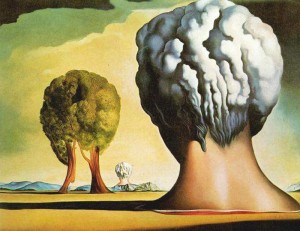 To take a small, simple example, I once helped a friend make sense of a disturbing dream in which she had attended a dinner party thrown by her older sister, where she was horrified to see her sister’s head resting on a food platter, like an hors d’oeuvre. I knew that my friend felt a bit threatened by her sister’s accomplishments, such as her recent purchase of a new home, so the meaning seemed apparent: “It’s about your jealousy that your sister is ahead.” My friend’s jaw dropped, and she quickly expressed shock that her own mind, hardly a punster, would have thought of representing the idea of “ahead” with a human head … or that it would have had the bad, violent taste to create such a macabre image of her sister.
To take a small, simple example, I once helped a friend make sense of a disturbing dream in which she had attended a dinner party thrown by her older sister, where she was horrified to see her sister’s head resting on a food platter, like an hors d’oeuvre. I knew that my friend felt a bit threatened by her sister’s accomplishments, such as her recent purchase of a new home, so the meaning seemed apparent: “It’s about your jealousy that your sister is ahead.” My friend’s jaw dropped, and she quickly expressed shock that her own mind, hardly a punster, would have thought of representing the idea of “ahead” with a human head … or that it would have had the bad, violent taste to create such a macabre image of her sister.
But in fact, everyone’s dreams, as well as their hypnagogic images, are packed full of these witty puns—most of them too brilliant to ever grasp (e.g., polysensory gags). It is no wonder that dreams and other visions have historically been assumed to be messages or thoughts from some other or divine source. It’s not only, as Freud thought, that we can’t believe ourselves capable of the wicked desires our dreams sometimes hint at; it’s also that we can’t believe our own minds are capable of being so astonishingly clever.
Although materialists who reduce our dreams, as well as our other profound visionary experiences, to brain effects seem to deflate our spiritual hopes, they can also be forgiven for trying to return our genius to us—that is, to de-alienate it. Hence Freud’s motto, “Wo es war, soll ich werden” or “Where It was, there I will be.” The least of us contains infinities, and genius, that are really unimaginable, if we only bother to peer into this seething Solaris-like realm and recognize it as belonging to us—or perhaps, realize us as belonging to it.
The Rashomon Brain: Hunting Duck/Rabbits, Seeing Multiple Realities
“A man walks along the beach and unfortunately gets hit in the head by a coconut. His head unfortunately cracks open in two halves. Then his wife comes along the beach singing a song and sees the 2 halves and recognizes them and picks them up. She gets very sad of course and cries heart breakingly. That is exactly where I am tired of poetry. Supposing the lady just picks up the 2 halves and shouts into them very angrily ‘Stop that!’” — J.D. Salinger, “Teddy”
The latest thing in Quantum physics, it seems, is the “Rashomon Effect”: Observers create reality, so there may be as many realities as there are observers. This relates to what I was getting at in previous posts, riffing on themes in Philip K Dick’s Exegesis: Reality is multiple and shifting. There’s no single “glass football” cosmic history but infinite variations on the theme.
Beyond the reality of multiple observers, the more troubling state of affairs is that even individual observers are “multiple” in several fundamental ways. There is firstly the notion that even on a subatomic level the particles in our bodies are in disgreement as to what is real, because of light’s (and thus causality’s) finite speed limit.
 But there is also the simple fact that our information about the world comes via multiple sensory channels and is processed in multiple ways in our brains. The basic fact that we see with two eyes, which gives us our 3-D picture of the world, means that even the two brain hemispheres must be regarded as separate observers of reality, having distinct interpretations and (one might suppose) “collapsing different wave functions.” The plurality of the psyche and the fact that the brain produces multiple separate representations, most notably within separate hemispheres that only imperfectly communicate with each other, produces something like a personal Rashomon Effect.
But there is also the simple fact that our information about the world comes via multiple sensory channels and is processed in multiple ways in our brains. The basic fact that we see with two eyes, which gives us our 3-D picture of the world, means that even the two brain hemispheres must be regarded as separate observers of reality, having distinct interpretations and (one might suppose) “collapsing different wave functions.” The plurality of the psyche and the fact that the brain produces multiple separate representations, most notably within separate hemispheres that only imperfectly communicate with each other, produces something like a personal Rashomon Effect.
Our brains juggle multiple realities, quite literally.
Fun With Dick and Jaynes
Dick wrote in his Exegesis that in the months prior to February 1974, when his mystical experience began, he had been taking megadoses of B and C vitamins according to a regimen he had read about in Psychology Today, an experimental treatment for schizophrenics designed to increase communication between the brain hemispheres. There is no way of knowing if this had anything to do with his altered perceptions, hypnagogic voices and imagery, and amazing synchronicities over the ensuing months, but among the sources that eventually gave him insight on his experience were books on the emerging science of brain hemisphericity, including Julian Jaynes’ pathbreaking 1976 work The Origin of Consciousness in the Breakdown of the Bicameral Mind. When Dick read a Time magazine article about Jaynes’ work in 1977, it seemed almost a perfectly timed answer to some of his most pressing questions, and indeed he felt that the theory confirmed conclusions he had arrived at based on his own experience.
 Jaynes’ book merged the then-new understanding of the separate functioning of the two brain hemispheres with the study of ancient cultures. Specifically, Jaynes argued that ancient humans always heard divine voices in their heads because their hemispheres did not intercommunicate to the degree that moderns’ brains do; thus voices from one hemisphere would be heard by the other as coming from outside—interpreted as spirits or gods. In the works of Homer, for instance, there is no evidence of characters possessing what we would call an inner life—they obey the dictates of divine commands.
Jaynes’ book merged the then-new understanding of the separate functioning of the two brain hemispheres with the study of ancient cultures. Specifically, Jaynes argued that ancient humans always heard divine voices in their heads because their hemispheres did not intercommunicate to the degree that moderns’ brains do; thus voices from one hemisphere would be heard by the other as coming from outside—interpreted as spirits or gods. In the works of Homer, for instance, there is no evidence of characters possessing what we would call an inner life—they obey the dictates of divine commands.
According to Jaynes’ interpretation, a major shift in consciousness occurred around 1250 BC, enabling the hemispheres to act with greater unity, and since then humans have no longer heard the voice of the divine Other and have felt spiritually alienated and forsaken as a result; but with this alienation, this Fall and expulsion from the Garden, we have earned our autonomy. The sense of loss Dick experienced when the internal presence of the divine faded drove him to attempt suicide in 1976. Thus he had particularly compelling reason to see himself reflected in those ancients who likewise suffered grief at the loss of the divine voice.
The Right Car Door
It might seem like a risky gambit for a Gnostic Christian like Dick to seek insights into transcendent experience in neurobiology, because it readily plays into the hand of the opposition: Granting wholism, meaning, the spirit world, cosmic consciousness, and gnosis to the “equally important” right hemisphere readily reinforces the bigger materialist picture that the divine or the spiritual are a product of brain processes and nothing more.
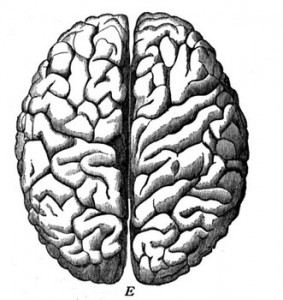 Jaynes himself was a committed materialist. In his Introduction to his book, he describes that while working on it he himself experienced a hypnagogic voice telling him to “include the knower in the known,” which he took merely as an interesting example of the kinds of voices heard routinely by the ancients; however (as Gary Lachman points out in his excellent book, A Secret History of Consciousness
Jaynes himself was a committed materialist. In his Introduction to his book, he describes that while working on it he himself experienced a hypnagogic voice telling him to “include the knower in the known,” which he took merely as an interesting example of the kinds of voices heard routinely by the ancients; however (as Gary Lachman points out in his excellent book, A Secret History of Consciousness), it never occurred to Jaynes to actually listen to that voice or follow its recommendation.
Dick, however, very creatively found ways of integrating materialist scientific theories with his spiritual intuitions and beliefs, and he converged on his own view of the brain that harmonized the materialist views of Jaynes and other split-brain thinkers with an emerging neo-Platonic Gnostic theology and his five-dimensional view of spacetime.
Critically, our conscious self is alienated from its banished half existing in orthogonal (fifth dimensional) time, roughly equivalent to the Platonic world of forms. To realize our forgotten larger self, an anamnesis (unforgetting) is required, facilitated by the “luminous redeemer”; crucially it is aspects of our neurobiology and neurochemistry that keep us alienated from this perpendicular stream of time and form—among other things, the inhibitory neurotransmitter GABA. But, Dick felt, humanity is on the verge of the next phase in its evolution, when this brain barrier will give way to a restored bicameral consciousness, called the “Ditheon,” able to perceive the two worlds we live in—the private world and shared world (idios kosmos and koinos kosmos)—simultaneously, or “parallactically.” He felt his own experience anticipated this coming human shift.
Left Brain vs. No Head
Dick would have found a firmer scientific and theoretical basis for his concept of the Ditheon mind in Iain McGilchrist’s monumental 2009 reconsideration of the problem of brain hemisphericity and its relation to culture, The Master and His Emissary.
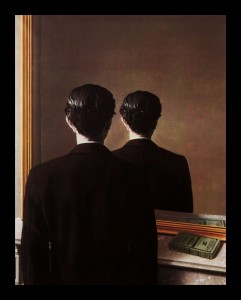 A mountain of evidence summarized by McGilchrist suggests that the left hemisphere, somewhat true to its stereotyped image, likes to nail down details, in sequential fashion, in an effort to control the world and avoid ambiguity at all costs. It likes to see things as definitive, static, and linear, and will jump to conclusions with unwarranted confidence. Language’s love of pinning labels on things goes along with this, although language is not solely rooted in the left hemisphere, as was once believed. The right hemisphere, in contrast to the left, sees the big picture and focuses more on caring for the world, finding meaning in it, and participating in it. This hemisphere is comfortable with indefiniteness, circularity (including circular notions of time), and inclusivity.
A mountain of evidence summarized by McGilchrist suggests that the left hemisphere, somewhat true to its stereotyped image, likes to nail down details, in sequential fashion, in an effort to control the world and avoid ambiguity at all costs. It likes to see things as definitive, static, and linear, and will jump to conclusions with unwarranted confidence. Language’s love of pinning labels on things goes along with this, although language is not solely rooted in the left hemisphere, as was once believed. The right hemisphere, in contrast to the left, sees the big picture and focuses more on caring for the world, finding meaning in it, and participating in it. This hemisphere is comfortable with indefiniteness, circularity (including circular notions of time), and inclusivity.
The interesting thing is that although the “wholist” right hemisphere is actually dominant in many respects, it can be lulled into a state of passivity by the frenetic instrumental behavior and extreme confidence of the left. In an argument that echoes but greatly nuances that of Jaynes, McGilchrist shows that the hemispheres’ opposed cognitive styles have tended to shift their balance because of cultural forces and fashions. We are currently, McGilchrist argues, in an extreme leftward swing: Under the parsing, instrumental left hemisphere’s direction, we have created a world of ecological and human exploitation and we have modeled our own society and even our own minds on the machine. Humanity’s present alienation comes from a kind of abdication of the throne, he says, letting the left-brain “emissary” take over while the right-brained “master” sleeps. If we persist on this cultural course, he suggests, we may end up creating a totally despirited social and technological environment that reproduces the kind of definitive mechanistic world the left hemisphere prefers to deal with, as a kind of materialistic self-fulfilling prophecy.
Unlike other neuroscientists interested in these problems, McGilchrist explicitly brackets the controversial question of the brain’s role in consciousness, concentrating instead on the inarguable role of the brain in giving structure to our experience. We live in two worlds, as philosophers have always pointed out, and any attempt to collapse them or subordinate one to the other is doomed to fail. Out of respect and deference for the non-definitive, McGilchrist even refrains from asserting (with a scientist’s usual left-brained force) that the divided nature of our mind is more than metaphorical. It is merely one way of looking at things.
Saying for instance that consciousness is a product of brain processes and nothing more would be a confident, left-hemisphere conclusion, but the left hemisphere isn’t always right and it cannot see the bigger picture. Yet instead subordinating matter to an all-encompassing notion of consciousness or some similar construct, as a host of recent anti-materialist thinkers like Deepak Chopra are doing (often invoking Quantum physics in their defense) may be similarly facile. We have to hold both perspectives—the materialist and the idealist—independently, simultaneously, even though they don’t add up.
McGilchrist goes so far as to concede that whether our two thought styles are really caused by the different functioning of two physical brain hemispheres (i.e., the whole neurophysiological basis for his argument) is ultimately less important than the fact that these cognitive styles exist as distinct, and the fact that they are fundamentally nonsymmetric and noncomplementary. This is what is so crucial and distinctive about his argument: These two worlds, these two alternative ways of perceiving, cannot be reconciled or collapsed into a synthesis; they don’t fit together or harmonize in any way.
In other words, it is not that the left hemisphere of the brain is in opposition to the right hemisphere. It is that the left hemisphere is in opposition to a standpoint that does not reduce things to material causes (such as brains or their hemispheres) at all. The left hemisphere is in opposition to no head.
Zooming in to the Void
The idea that at the core of our apprehension of the world is a nonsymmetrical opposition between two points of view that are utterly irreconcilable is also basic to Slavoj Žižek’s philosophy as the core idea of “parallax.” Various irreconcilable dualities in human knowledge (such as the wave/particle duality in physics or the reductive neuroscientific stance that consciousness is an illusion versus the meaningful world as humans really experience it) and even basic aspects of human experience like the irreconcilable rift between the sexes are reflections/effects of various fundamental divisions or antagonisms in our apprehension of the world, including things’ basic non-identity with themselves.
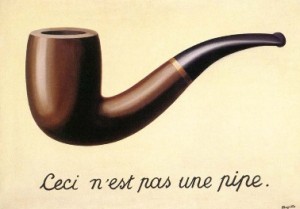 The latter division arises from the arbitrary and shifting relationship between the phenomenal world as it is digested in the imagination (the Imaginary) and the overlay of words and concepts that gives our mental images meaning (the Symbolic). In our daily consciousness we must pretend these match up harmoniously, that things have selves, but this is really a delusion. (This effect of the linguists’ “arbitrariness of the linguistic sign” is named in Buddhist philosophy as the doctrine of “no-self.”)
The latter division arises from the arbitrary and shifting relationship between the phenomenal world as it is digested in the imagination (the Imaginary) and the overlay of words and concepts that gives our mental images meaning (the Symbolic). In our daily consciousness we must pretend these match up harmoniously, that things have selves, but this is really a delusion. (This effect of the linguists’ “arbitrariness of the linguistic sign” is named in Buddhist philosophy as the doctrine of “no-self.”)
The impossibility of merger between the Symbolic and Imaginary becomes clear if you imagine a landscape and, over it, a projected contour or highway map. The belief in self-identity is the belief that the map can be inscribed in the landscape and merged with it. But even if you slapped a label or sign on every object in that landscape, saying “what it is,” would it really affect the is-ness of anything? If you painted the name of a road on the road, or even worked the name into the asphalt using differently colored tar, there would be vast parts of the pavement with no name, and you could crouch or zoom down in to any point in the landscape to a scale smaller than the label and arrive at the same unlabeled nothing.
The fact that a name cannot be merged with a thing is merely amusing when presented in the form of an object lesson like Magritte’s famous “This is not a pipe” painting. But there’s a real trauma in it. This subtle trauma can be experienced on any modern smartphone navigation app such as Google Maps. When you zoom in to a view a neighborhood more closely, the scale of the city blocks themselves enlarge, but the size of icons for landmarks and streets do not, nor do the map’s verbal labels. Zooming in further, you may disconcertingly zoom in so much that you lose all references: The name of a city or neighborhood hovers in a blank blue or gray emptiness, unattached to any image. This unsettling vacuousness, which seems like a glitch or imperfection in the software, is an experience of the Real.
We may attempt to flee or escape the Real through various “unitary” cheats—coming down firmly on either side of the materialism/idealism divide, for example: Being resolutely left-brained is one way to evade existential terror, just as being resolutely right brained is. But precisely according to the truism that a genius is the ability to hold two contradictory ideas simultaneously, advanced (and actually, ultimately blissful) thinking demands living in the excluded middle rejected by Aristotelian logic.
Theater of the Surd
Žižek emphasizes the parallactic nature of the Real as a counter to what he sees as facile New Age yin/yang images of harmony and complementarity, which strike him nothing better than a version of the naive literalism that conflates words and things. Lacan’s own adoption of the dollar sign, $, as his symbol for the “split subject,” the person decentered and alienated by language, could almost be seen as expressing precisely the same critique: It is as if either yin or yang (it doesn’t matter which one) is being jammed together with something that has been cut along a straight edge rather than an S-shaped curve. There is no complementarity to these halves, and instead there is a zone of inconsistency, illogic, doubling and gaps, and paradox.
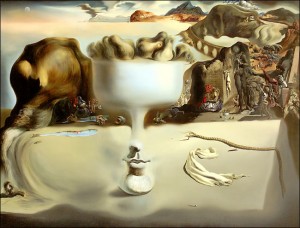 This liminal zone where the consistency of the world breaks down, the Real, is exactly the realm of what Dick (borrowing a term from mathematics for irrational numbers) called the “surd” in the most breathtaking late entries in his Exegesis:
This liminal zone where the consistency of the world breaks down, the Real, is exactly the realm of what Dick (borrowing a term from mathematics for irrational numbers) called the “surd” in the most breathtaking late entries in his Exegesis:
When all the metaphysical and theological systems have come and gone there remains this inexplicable surd: a flurry of breath in the weeds in the back alley—a hint of motion and color. Nameless, defying analysis or systematizing: it is here and now, lowly, at the rim of perception and being. Who is it? What is it? I don’t know.
But even though this “place” of breakdown may appear to be part of the world’s landscape, it is really hovering between us and the landscape, as well as behind and within the landscape, like a weird optical illusion or hologram whose distance is impossible to fix.
Writers have generally described the Lacanian Real as whatever lies beyond the scope of human symbolism and imagination—the unnameable and the unrepresentable—but Žižek asks us to think of it as a mirage created by the constant oscillation among irreconcilable perspectives. It doesn’t exist, yet just as Dick says of the surd, it exerts a tug, an influence, on the world, the way the moon tugs at the Earth’s oceans. For Žižek, too, the Real is a pure semblance, a nothing, yet one that pulls on us, like a gravitational field bending our perceptions and our desires. Instead of being beguiled by the mirage, he says, we must penetrate it and attempt to grasp the multiple separate points of view that give rise to it, somehow apprehending them simultaneously.
Between Two Worlds
The mystical is the realm of the Real because it resists the dual pull of names and imagination. The place of mystical apprehension has always been described as precarious and difficult to enter and abide in deliberately—like a razor’s edge—precisely because the mind dislikes instability and uncertainty; it needs images and concepts to pin things down. Nevertheless, building the mental muscle of accepting inconsistency, cognitive dissonance, and even “impossibility” produces the ability to abide in the Real, balance on that razor’s edge, for longer and longer periods of time.
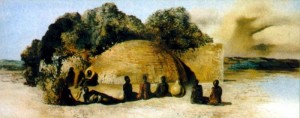 Indeed, although Žižek might be horrified to have his concept linked to Buddhism (which to him is basically ‘New Age obscurantism’), his description of parallax and void in The Parallax View
Indeed, although Žižek might be horrified to have his concept linked to Buddhism (which to him is basically ‘New Age obscurantism’), his description of parallax and void in The Parallax View comes close to capturing the actual felt experience of Zen meditation: an uncomfortable-at-first nowhere in which you cannot find your place or rest in secure signification or imagination. It is important to be clear: This discomfort has nothing to do with the physical discomfort of the seated postures emphasized by many contemporary Zen teachers in America—ritualistic painful sitting is not essential for Zen meditation. I’m referring to a mental/emotional discomfort, felt in the torso and whole body, as vague unease or physical dislocation. But this weird sense of placelessness becomes, over time, increasingly pleasurable and enriching, increasingly a home to return to and a source of strength and insight.
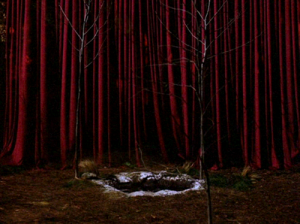 I’ve described elsewhere that David Lynch’s world of Twin Peaks, with its curtained spirit world shimmering in and out of view and its ominous sentient breeze rustling the pines, perfectly captures the transfigured sense of the world in the aftermath of meditation. Lynch, through his own daily mantra meditation practice, has been honing and deepening his access to the Real for over four decades, and Žižek (who lacks experience with the wordless) is quite mistaken when he dismisses this side Lynch as soft-headed. Lynch is a rigorous explorer of the Real, apprehending and expressing this zone and its effects in the only way possible. Žižek, for all his brilliance, can only talk around the Real, in endless symptomatic loops of wordy repetition that never get at the thing itself.
I’ve described elsewhere that David Lynch’s world of Twin Peaks, with its curtained spirit world shimmering in and out of view and its ominous sentient breeze rustling the pines, perfectly captures the transfigured sense of the world in the aftermath of meditation. Lynch, through his own daily mantra meditation practice, has been honing and deepening his access to the Real for over four decades, and Žižek (who lacks experience with the wordless) is quite mistaken when he dismisses this side Lynch as soft-headed. Lynch is a rigorous explorer of the Real, apprehending and expressing this zone and its effects in the only way possible. Žižek, for all his brilliance, can only talk around the Real, in endless symptomatic loops of wordy repetition that never get at the thing itself.
Another comparison would be Salvador Dali with his “paranoic-critical” images: landscapes and objects that are haunted by a latent image, an alternative way of perceiving the same landmarks. It is sort of in these terms that I imagine Dick’s experience seeing ancient Rome mapped onto modern Orange County: a kind of flickering imaginal overlay. In being able to see this, as well as detecting the ‘surdity’ (or Real) in the “trash stratum” of mundane existence, Dick felt that he was accessing a new Ditheon consciousness that, by integrating the brain hemispheres, was able to see two realities at once. Dick felt this capacity, which the Native American shamans described as being a “walker between two worlds,” was possibly the next phase in our cognitive evolution.
Making Flippy-Floppy
Possibly we would see Valis as a flicker of on-off, on-off, on-off, a flip-flop back and forth in its ceaseless dialectic that is in it but beneath it … All this is very much like what Heraclitus taught and he would probably have called Valis Logos. [Dick, Exegesis]
Ditheon perception could represent an evolutionary leap forward or a lapse into paranoia and madness—there’s probably a fine line (or heck, an overlap). I do think Dick is describing a capacity that mainstream, left-brained, materialist psychology has been far too hasty to deny the possibility of.
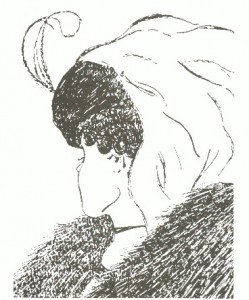 It is almost axiomatic in psychology that our perceptual-cognitive apparatus cannot tolerate contradictions or multiple meanings, and thus when faced with ambiguity, we are compelled to adopt some single stable interpretation, one that is consistent with the rest of our world, rejecting all contradictory data. Consider the classic multistable images we’ve all seen in Psychology 101 textbooks: Perceptual psychologists like to claim we can’t avoid falling into the trap of seeing either a young beautiful wife or a hideous mother-in-law (left), or either a duck or a rabbit (below). Our perception may flip-flop, but it is always stated as fact that we can’t see a duck and a rabbit (or a wife and a mother in law) simultaneously.
It is almost axiomatic in psychology that our perceptual-cognitive apparatus cannot tolerate contradictions or multiple meanings, and thus when faced with ambiguity, we are compelled to adopt some single stable interpretation, one that is consistent with the rest of our world, rejecting all contradictory data. Consider the classic multistable images we’ve all seen in Psychology 101 textbooks: Perceptual psychologists like to claim we can’t avoid falling into the trap of seeing either a young beautiful wife or a hideous mother-in-law (left), or either a duck or a rabbit (below). Our perception may flip-flop, but it is always stated as fact that we can’t see a duck and a rabbit (or a wife and a mother in law) simultaneously.
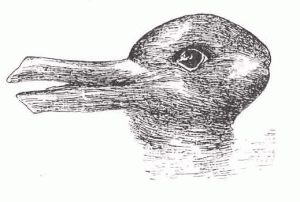 The philosopher Wittgenstein noted, however, that it is at least possible to say “It’s a duck-rabbit” and to recognize the image as such; I believe it may also be possible, with difficulty, to see its dual reality. If you hang a duck-rabbit on your wall and stare at it in idle moments for a few weeks, it starts to change. The two aspects themselves morph and distort, and eventually, I find, the flip-flop actually accelerates, becoming more of an anxious flicker; if you try, you can almost, for the briefest instant, see just an ambiguous shape or an unrelated object (for instance, some kind of sinister mutant squid or vegetable). This breakdown of the sense of the image reminds me of what occurs when you repeat a familiar word over and over 50 or 100 times: It temporarily loses its meaning and seems strange.
The philosopher Wittgenstein noted, however, that it is at least possible to say “It’s a duck-rabbit” and to recognize the image as such; I believe it may also be possible, with difficulty, to see its dual reality. If you hang a duck-rabbit on your wall and stare at it in idle moments for a few weeks, it starts to change. The two aspects themselves morph and distort, and eventually, I find, the flip-flop actually accelerates, becoming more of an anxious flicker; if you try, you can almost, for the briefest instant, see just an ambiguous shape or an unrelated object (for instance, some kind of sinister mutant squid or vegetable). This breakdown of the sense of the image reminds me of what occurs when you repeat a familiar word over and over 50 or 100 times: It temporarily loses its meaning and seems strange.
This “meaningless” apprehension, which would be a kind of peace-making with cognitive dissonance, is exactly the aim of contemplative techniques like Zen: Once you somewhat build the muscle of non-attachment and can resist cognitively rushing in to an involvement (or interpretation) with the seen, things begin to manifest in their “suchness”—that is, just as they are—initially for brief flickering instants or a few seconds; eventually you can abide in this precarious in-between place for longer durations.
Because they pose such a challenge and invitation, I suspect that multistable images like duck-rabbits would be ideal visual koans for intensive meditation. (Some of Magritte’s similarly ambiguous images can also function this way.)
The Real and the Paranormal
Paranormal phenomena belong to this indeterminate, hard-to-see landscape where duck-rabbits frolic and play, because they evade nearly all attempts to pin them with concepts and labels. This quality has been described by some researchers as “tricksterish,” but a future theory of paranormal phenomena could profitably adopt Lacanian language instead. The paranormal is about as “Real” as it gets.
UFOs and related phenomena, because of their maddening ambiguity, make great tools for meditation. I am also beginning to think that the reverse may also be the case: Developing ones parallactic or ‘Ditheon’ mental capacity through engaged meditation and staring at duck-rabbits is possibly the necessary prerequisite for experiencing, and probably making progress understanding, paranormal phenomena.
For example there are scattered, tantalizing hints throughout the UFO literature that they or their associated intelligences might be somehow drawn to persons in meditative states. Examples include Whitley Strieber’s habit of Zen meditation with his visiting grays; the observation by Skinwalker Ranch researchers that meditation might act as bait for the bizarre phenomena they observed; or even the reputed tendency of UFOs to appear near Nikolai Kozyrev’s lab in Siberia when his mirrors were being used to focus mental energy. But it could simply be that UFOs are all around and it is just our ordinary left-brained definitive minds that keep us from seeing them.
It is also no accident that a mystical practice (or “yoga” in the ancient Patanjali sense—which just meant meditation) is widely regarded as a necessary prerequisite to build psi ability. Even outside of an Eastern religious or yogic framework, many writers on ESP have described meditative states as essential, both for getting outside our categorical/definitive/conceptual left brains (what Ingo Swann called “analytical overlay”) and for temporarily setting aside or at least minimizing our petty egos and biases and distort our interpretations of what we see.
Lynch thinks we could create a better, more humane world if everybody meditated. I would add that getting everyone to meditate might create a more paranormal world, too.
Spock Was a Zen Man
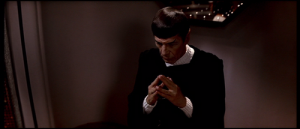
Leonard Nimoy was, without a doubt, the most decisive influence on my spiritual life. He provided my first model of the mystical path, when I first started becoming curious about such things as a teenager.
When creating the character of Mister Spock, Nimoy was drawing directly from his childhood experiences of Orthodox Judaism, but I would only learn that much later. (Nimoy described the Jewish roots of Spock in a wonderful interview here.) At the time, when I was curled up in my beanbag chair every afternoon in our family rec room watching Star Trek reruns after school, I connected Spock’s Vulcan mental mastery with Eastern religion—specifically, with a story told by Eugen Herrigel in a little paperback I had bought at the bookstore (or perhaps been given), The Method of Zen.
One day on a trip to Tokyo in the 1920s, Herrigel was having lunch with a Japanese colleague when an earthquake struck. Panic quickly broke out, and most of the diners (including Herrigel) jumped up to hurry out of the restaurant. But the man Herrigel was having lunch with remained seated with his hands folded, his eyes nearly closed, completely undisturbed by the shaking going on around them. Fascinated by his companion’s trance-like calm, Herrigel sat down too and felt strangely safe, almost like the man’s trance put out some kind of force field protecting them. When the earthquake was over, the man continued the conversation exactly where it had broken off, saying nothing about what had just happened.
A few days later, Herrigel learned the source of his lunch partner’s amazing, infectious calm—he was a Zen Buddhist, whose emotional steadiness came from years of practicing meditation. Herrigel was sold. He went on to apprentice himself for four years with a Zen archery master and, from that experience, wrote the classic Zen and the Art of Archery.
Zen literature is full of stories of people achieving great feats of insight, physical skill, and mastery of their base emotions after years of focusing their minds. They often become rocks of support, quietly giving strength to others without being burdened by the ego that obscures and obstructs most people.
This seemed to me exactly like Spock—kind and compassionate, able to mentally connect with other beings (even the most exotic), and with a keen and brilliant mind that was unswayed by human passions, delusions, and fears. When alone, he was often shown sitting, eyes half shut, deep in meditation. To this day, I still see the Zen model as being something like a calm, compassionate alien taking a quiet, protective, healing role in the world of panicked humans.
Connecting Herrigel’s story to Spock made a huge impression on me, at a time when I was very impressionable. My hero, Spock, was clearly a Zen man, and I badly wanted to be one of those too.
I wonder how many other young people mistook Nimoy’s “Jewish” alien as a Zen master, sending them headlong on a rewarding, lifelong embrace of Zen or other Eastern religious paths?
The Passion of Einstein: Light, Spacetime, and the Holy Grail

In David Lindsay’s bizarre Gnostic allegory A Voyage to Arcturus, space travel is accomplished by means of “back light”—light rays that strive to return to their origin. A bottle of back light gathered through a telescope aimed at Arcturus is used to pull a small ship and its passengers from an observatory in Scotland up to that distant star system.
 If you think about it, “back light” does exist in some sense, and is inseparable from light itself. We are used to hearing how light from a star took X many years to reach our eyes, and thus, when looking at that star, we are seeing into the past. In the case of Arcturus, which is 36.7 light years distant, I see photons that started their journey across space when I was ten years old. This truism that we look into the past when we gaze into space tends to reinforce the dualistic separateness of subject and object … but there is another way of looking at it.
If you think about it, “back light” does exist in some sense, and is inseparable from light itself. We are used to hearing how light from a star took X many years to reach our eyes, and thus, when looking at that star, we are seeing into the past. In the case of Arcturus, which is 36.7 light years distant, I see photons that started their journey across space when I was ten years old. This truism that we look into the past when we gaze into space tends to reinforce the dualistic separateness of subject and object … but there is another way of looking at it.
Light is the medium of communication of events and forces, and thus, of causality itself. Einstein grasped that If you tried to run alongside light, it would seem to outpace you by the same amount no matter how fast you were running. But if you were light, everything would be in a state of eternity and immediacy. Really, there are no objects, only relationships defined by interacting electromagnetic quanta, which is not a “communication of information” but, seen from the perspective of higher dimensions, something much more. Light really “goes both ways” or, more correctly, doesn’t go at all. There is nowhere to go, from the point of view of light.
 Thus when I see Arcturus there in the sky, we are really united. Those photons that “left” Arcturus nearly four decades ago and are now reaching my eye are, when viewed four- or more-dimensionally, the actual touch of the star and my eye, reaching across purely illusory decades. Within such a perspective, I am potentially in communion with all places and all times. I touch Arcturus at the same time that it touches me. (Moreover, given the Uncertainty Principle, my seeing and registering those photons is actually affecting that star 36.7 years ago, in some tiny subatomic way. In a butterfly-effect universe, ought those tiny subatomic effects of distant observation not add up to substantial effects over the course of cosmic history?)
Thus when I see Arcturus there in the sky, we are really united. Those photons that “left” Arcturus nearly four decades ago and are now reaching my eye are, when viewed four- or more-dimensionally, the actual touch of the star and my eye, reaching across purely illusory decades. Within such a perspective, I am potentially in communion with all places and all times. I touch Arcturus at the same time that it touches me. (Moreover, given the Uncertainty Principle, my seeing and registering those photons is actually affecting that star 36.7 years ago, in some tiny subatomic way. In a butterfly-effect universe, ought those tiny subatomic effects of distant observation not add up to substantial effects over the course of cosmic history?)
We may think of ourselves as a human-shaped bodies here where we are in space and nowhere else, but from the point of view of light we are pulled apart in every possible direction, and thus have the shape of the universe. We are dissolved in spacetime. Thus the simple concept of “world lines”—of our present selves as “sections” of a worm moving through a static glass football—is really mistaken, as I argued in my previous post on eternalism. Not only are our “worms” impossibly fuzzy, extending to all points in spacetime, they also shift and shimmer and change depending on your vantage point. There’s no one history but infinite variants depending on one’s point of view.
Time, the fourth dimension, is not fixed, but is subject to the rule of light and thus, I suggest, subject to crucial “traumatic” vagaries arising from the fact that light obeys a fixed speed limit. Yet at the same time, by being the very medium of cosmic causal communion, light offers its own “salvation.” In this dual nature, light, the shaper of Time, is very much like the “blood of Christ” in the Christian imagination.
Dick Symbols
In his Exegesis (and its fictionalized version, Valis), Philip K. Dick kept returning to the Grail kingdom from Wagner’s opera Parsifal to explain his emerging Gnostic conceptualization of the relationship between Platonic forms and Time, or, between cold crystalline history (the 4-D football of Minkowski or Alan Moore, previous post) and a hyperfootball universe in which salvation is possible.
 When the young knight (Parsifal) is brought to the Grail castle, he notices that he is walking but doesn’t seem to move. The chief Knight of the Grail explains that, “Here, my son, time turns into space.” The Grail itself is what Dick calls a “common constituent,” a node of eternity around which history circles and that, as a result, has salvific power—just like the Jesus fish around a young woman’s neck that triggered his mystical experience (or psychotic break, depending on your interpretation). Dick writes in his Exegesis that “This is how … the Eucharist works, how through the sacrament ‘time is overcome’—normal time becomes space … My 5-D realm … is the realm of Kosmos Noetos, hence logos, hence the realm of Christ.”
When the young knight (Parsifal) is brought to the Grail castle, he notices that he is walking but doesn’t seem to move. The chief Knight of the Grail explains that, “Here, my son, time turns into space.” The Grail itself is what Dick calls a “common constituent,” a node of eternity around which history circles and that, as a result, has salvific power—just like the Jesus fish around a young woman’s neck that triggered his mystical experience (or psychotic break, depending on your interpretation). Dick writes in his Exegesis that “This is how … the Eucharist works, how through the sacrament ‘time is overcome’—normal time becomes space … My 5-D realm … is the realm of Kosmos Noetos, hence logos, hence the realm of Christ.”
People have imagined that somehow Wagner anticipated Einstein’s General Theory of Relativity and its equivalence of space and time. Indeed, similar objects (like Dick’s common constituents) do have a central place in cosmology, as singularities—places where Time breaks down under the enormous mass/gravitational force of a collapsing star and its subsequent ravenous hunger.
 Theoretically there is no history inside the singularity of a black hole, and I think it has also been proposed that there may be no difference between different singularities—the guts of all black holes might all, really, be the same no-place, out of Time and out of Space. Hence the conceptual linkage of black holes to hyperspace, wormholes, and time travel—even the vicinity or edges of such objects could draw together distant regions of space and time and thus provide shortcuts between them. In the wonderful novel Fiasco by Stanislaw Lem, a zone of retarded time near a black hole, which he dubs a “bradychronality,” is used to synchronize the histories of an interstellar mothership and its exploration vessel; a similar plot device is used in Christopher Nolan’s Interstellar.
Theoretically there is no history inside the singularity of a black hole, and I think it has also been proposed that there may be no difference between different singularities—the guts of all black holes might all, really, be the same no-place, out of Time and out of Space. Hence the conceptual linkage of black holes to hyperspace, wormholes, and time travel—even the vicinity or edges of such objects could draw together distant regions of space and time and thus provide shortcuts between them. In the wonderful novel Fiasco by Stanislaw Lem, a zone of retarded time near a black hole, which he dubs a “bradychronality,” is used to synchronize the histories of an interstellar mothership and its exploration vessel; a similar plot device is used in Christopher Nolan’s Interstellar.
Wagner’s Grail kingdom, with its bleak repetitive ritual and its grim knights who seem trapped in amber, is like one of Lem’s black-hole bradychronalities. Wagner apparently used elaborate sets and choreography to visually convey this sense of movement-in-immobility. (I have never seen Parsifal performed but I have been near a black hole many times, and frustratingly walking without seeming to move is exactly what it is like.)
Sublime Objects
Things not unlike Dick’s “common constituents” also have a central place in the Lacanian-Hegelian philosophy of Slavoj Žižek, as what he calls “sublime objects”: inaccessible, simultaneously fascinating and threatening or even horrifying remnants of trauma that rupture the symbolic universe—the universe of meaning—but also anchor it in place, just like the imperious supermassive black holes at the heart of galaxies, around which all stars circle in stately obedient procession.
 In the vicinity of a sublime object, history gets caught in endless orbital loops of fixation and repetition, thus they form the nuclei of individual fetishes and neurotic symptoms as well as religious rituals and political ideologies. Žižek’s classic example is the remains of the Titanic, which spookily fascinated viewers when the wreck was discovered in the early 1980s. Other examples would be the ruins of the World Trade Center towers after 9/11, or the ruins of Auschwitz/Birkenau; both represent the site of a horrible trauma, yet both are also repeatedly revisited and “enjoyed” in a kind of pathological-obsessive way.
In the vicinity of a sublime object, history gets caught in endless orbital loops of fixation and repetition, thus they form the nuclei of individual fetishes and neurotic symptoms as well as religious rituals and political ideologies. Žižek’s classic example is the remains of the Titanic, which spookily fascinated viewers when the wreck was discovered in the early 1980s. Other examples would be the ruins of the World Trade Center towers after 9/11, or the ruins of Auschwitz/Birkenau; both represent the site of a horrible trauma, yet both are also repeatedly revisited and “enjoyed” in a kind of pathological-obsessive way.
The real tendency of subjective time to slow down during crises and disasters, as well as the Freudian neurotic compulsion to engage in repetitive behavior around our traumas, suggests that the connection between weighty trauma and the gravity that bends spacetime may be more than metaphorical. Milan Kundera keyed in on this with his meditation on lightness and weight in The Unbearable Lightness of Being: Things are light and insubstantial if they never repeat or return; only if they repeat are they consequential and serious; cosmology reverses this causal priority of weight and repetition (or spacetime curvature): Only if events are heavy (like a trauma) do they cause things to go in circles or repeat. But indeed, both perspectives are fine, because in the vicinity of such a “heavy” formation, causality breaks down and there is no single temporal dimension, no before and after; the future causes the past as much as the past causes the future.
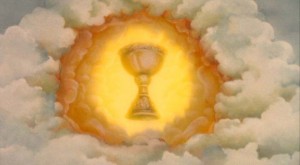 Sublime objects, the material form taken by the condensed compacted jouissance or “enjoyment” at the heart of personal and collective symptoms, are the same as the sacramental formations (common constituents) that give structure to Dick’s orthogonal time. Dick suggests it is not simply that forms repeat and exist in some kind of spacetime resonance with each other (as in Rupert Sheldrake’s theory of morphic fields); it is that the Jesus fish around the neck of a young woman in Orange County, CA in February 1974 is really in some sense the same Jesus fish as one worn by a secret Gnostic Christian in first century Syria.
Sublime objects, the material form taken by the condensed compacted jouissance or “enjoyment” at the heart of personal and collective symptoms, are the same as the sacramental formations (common constituents) that give structure to Dick’s orthogonal time. Dick suggests it is not simply that forms repeat and exist in some kind of spacetime resonance with each other (as in Rupert Sheldrake’s theory of morphic fields); it is that the Jesus fish around the neck of a young woman in Orange County, CA in February 1974 is really in some sense the same Jesus fish as one worn by a secret Gnostic Christian in first century Syria.
For most of the medieval and later writers who penned romances about knights seeking the Holy Grail, that object is precisely such a sublime, “out of time and sense” object, specifically because it implicitly holds Christ’s saving blood—the remnant or leftover of a primal trauma, which is also the only thing that (according to medieval Christianity) can save us. In fact, throughout his prolific career, Žižek, like Dick, has also continually used Wagner’s Parsifal to illustrate his theory. In the Grail King Anfortas’s realm, history has slowed to halt, circling repeatedly in the warped spacetime of obsessive pleasurable-painful jouissance, symbolized by the chronically festering wound on his thigh, which can only be cured by the spear that caused it—the spear that impaled Christ as he hung on the cross and is now possessed by Anfortas’s enemy, the evil wizard Klingsor.
The Flickering Grail
 The central Christian “saving trauma” is of course Christ’s martyrdom in Jerusalem. The genius of the early Grail writers was to more clearly draw out the connection, only latent in the canonical Gospels, between Jesus’s blood ingested by his disciples at the Last Supper and the blood Christ shed on the Cross a couple days later. The romances “flicker” about which object this cup is: the cup the disciples drank from, which became symbolically the Eucharist cup in the Mass, or the cup used by Joseph of Arimathea to collect Christ’s blood after his crucifixion, when his body was lowered from the cross. The latter scene, the “Deposition,” does not appear in the canonical Gospels but in the apocryphal Gospel of Nicodemus, which was popular at the time.
The central Christian “saving trauma” is of course Christ’s martyrdom in Jerusalem. The genius of the early Grail writers was to more clearly draw out the connection, only latent in the canonical Gospels, between Jesus’s blood ingested by his disciples at the Last Supper and the blood Christ shed on the Cross a couple days later. The romances “flicker” about which object this cup is: the cup the disciples drank from, which became symbolically the Eucharist cup in the Mass, or the cup used by Joseph of Arimathea to collect Christ’s blood after his crucifixion, when his body was lowered from the cross. The latter scene, the “Deposition,” does not appear in the canonical Gospels but in the apocryphal Gospel of Nicodemus, which was popular at the time.
I think we can really see the Grail as both objects simultaneously, and that its atemporal “absurdity” is essential to the salvific nature of Christ’s blood: How could the blood shed on the Cross have gotten into the cup of the Last Supper other than by having traveled back in time? Christ’s blood is either made of tachyons (hypothetical faster-than-light particles that most physicists currently reject) or is, in effect, outside of linear Time altogether. Only if Christ’s blood is outside of Time and Cause does it make sense that the cup that once ever held it must have always held it and will keep holding it eternally—and there is just one thing known to physics that has those properties: The blood of Christ is, in effect, light.
 We see then that, from a Gnostic point of view, Christ’s passion isn’t about anybody called Christ. It is about light and matter and space and time—in other words, causality itself, the very “order of things.” From the fifth-dimensional viewpoint of Dick and Wagner, Christ’s Passion on the cross is kind of solidified, four-dimensional hieroglyph of nothing other than Einstein’s theory of Relativity. Light, like Christ’s saving blood or the Grail that holds it, is unattainable, always at the same distance from us (as long as we are in our fallen, darkened state), yet it is also the very medium of cosmic communion that can save us. (It is no accident, I think, that Lacan also described the Real, the home of enjoyment, as something that is always the same distance from us despite whatever efforts we make to approach or get distance from it: It’s always, he said, “glued to our heel.”)
We see then that, from a Gnostic point of view, Christ’s passion isn’t about anybody called Christ. It is about light and matter and space and time—in other words, causality itself, the very “order of things.” From the fifth-dimensional viewpoint of Dick and Wagner, Christ’s Passion on the cross is kind of solidified, four-dimensional hieroglyph of nothing other than Einstein’s theory of Relativity. Light, like Christ’s saving blood or the Grail that holds it, is unattainable, always at the same distance from us (as long as we are in our fallen, darkened state), yet it is also the very medium of cosmic communion that can save us. (It is no accident, I think, that Lacan also described the Real, the home of enjoyment, as something that is always the same distance from us despite whatever efforts we make to approach or get distance from it: It’s always, he said, “glued to our heel.”)
Why is light a “trauma” for causality? Because of its fixed speed limit. Einstein’s famous “train-car” thought experiments must describe the state of affairs on even a subatomic scale: Electromagnetic radiation emitted from a given source at a given time reaches different “receiving” particles at slightly different times, meaning that causality itself is “warped” at the most fundamental level. One particle must have a different “story” of reality than the story told by a neighboring particle. This is why the luminiferous fuzz of our world-worms is in a constantly flickering either/or or both/and state; by extension the whole universe is multiple, shimmering, contradictory, and radically indeterminate or open-ended.
 It is tempting to see the two thieves crucified along with Christ (described in Luke as well as some of the noncanonical gospels)—one who repents and follows the savior to heaven, and one who does not repent and goes to hell—as a figuration of light’s parallactic nature: That it separates, divides reality from itself, as much as it, on another level, unifies.
It is tempting to see the two thieves crucified along with Christ (described in Luke as well as some of the noncanonical gospels)—one who repents and follows the savior to heaven, and one who does not repent and goes to hell—as a figuration of light’s parallactic nature: That it separates, divides reality from itself, as much as it, on another level, unifies.
The Virtuality of Time and Space
Kant saw Time and Space as embedded structures in our brains, not as actual realities, and this helped pave the way for science to question the objective solidity and stability of the material world. As the Buddhists have always said, “nothing exists”—there is no stable self, no objective world of events. Žižek would agree, saying that Time itself (or history) is a perspective mistake, something purely virtual and nonexistent. There is only a structure of meaning which always changes “in retrospect”—which really just means, changes depending on your point of view.
 Žižek’s name for what Buddhists call “no self” is parallax. We literally see from two slightly different places, as well as always interpreting the world within rival incommensurable symbolic frameworks. For Žižek, though, the sense of stable reality is not something undercut by parallax, but actually created by it. The Real is an “optical illusion” created by a constant alternation between slightly divergent vantage points.
Žižek’s name for what Buddhists call “no self” is parallax. We literally see from two slightly different places, as well as always interpreting the world within rival incommensurable symbolic frameworks. For Žižek, though, the sense of stable reality is not something undercut by parallax, but actually created by it. The Real is an “optical illusion” created by a constant alternation between slightly divergent vantage points.
Recent neuropsychological research has revealed how parallax may work to create the illusion of Time: The sense of the now as having a duration arises from a resonance between slightly temporally offset “functional moments”; the resulting mini-Now or “experienced moment” (lasting 2-3 seconds) along with the slightly longer-duration function of working memory is what enables us to understand language and experience music, for example: building up “chords” of meaning from sequential sounds, perceptions, and thoughts that the brain binds together and unifies into a coherent whole. The ongoing juxtaposition of temporally offset experiences creates the illusion of Time as a dimension having its own volume or extension.
Examining mental activity in meditation reveals that the illusion of self or self-identity arises from a similar process, the constant automatic generation of imaginary representations of our experience—the “autosymbolization” function of the ongoing hypnagogia usually operative just underneath conscious awareness. These images spun off from successive moments of perception (also about every 2-3 seconds) hover over reality like ghosts, an imaginary “I” seeing as well an imaginary gaze seeing me seeing, etc., as well as forming the nuclei or seeds for trains of thoughts. These virtual representations give a Parmenidean sense of permanence and persistence (or at least, viscosity) to the Heraclitean river.
It seems like something analogous could be operative on even the “informational” (really, communal) Quantum world of matter, where the “flicker” or juxtaposition of subtly different realities (think Christ’s two thieves traveling in different directions) might generate what we interpret as the world’s material solidity. Remember that, optically, shifting among multiple points of view is what gives the world its apparent dimensionality—the 2-dimensional visual field (image) becomes 3 dimensional (volume) under parallax. By extension, the 3 dimensions of volume may (under “hyperparallax”) become 4 dimensional—not as Time, but as mass.
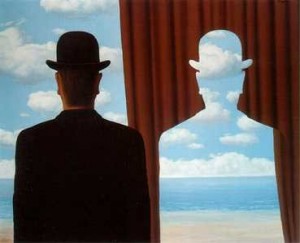 Mass could in other words be a “special effect” or illusion arising from objects’ noncoincidence with themselves on a fundamental material level, due to the fact that light (and thus causality) is a Constant with a speed limit. Perhaps mass could be thought of as the provisional “agreement” arrived at by all those confused/disputing subatomic particles who, like Einstein’s train passengers, see the world slightly differently depending on exactly how far along the track they are.
Mass could in other words be a “special effect” or illusion arising from objects’ noncoincidence with themselves on a fundamental material level, due to the fact that light (and thus causality) is a Constant with a speed limit. Perhaps mass could be thought of as the provisional “agreement” arrived at by all those confused/disputing subatomic particles who, like Einstein’s train passengers, see the world slightly differently depending on exactly how far along the track they are.
According to General Relativity, mass curves Space, and this curvature gives rise to Time. But it seems we could also think of mass as the “flip side” of Time (or of the Bergsonian “duration” and Heraclitean flux that we interpret as Time): Duration, transitoriness, and change arise, with mass, as a way for particles to resolve their “cognitive dissonance” over relativistic absurdities.
If that is the case, the “fourth dimension” would really be a kind of circular (you might say “ouroboric”) return from 3 dimensions back to 2, and thus our ordinary “fallen” sublight world would exist in a fractional dimensionality somewhere between 2 and 3. This would correspond well to Gerard ‘t Hooft’s holographic theory (which I discussed in my post on anamorphosis), which posits a flat, 2-dimensional spacetime at high energies as the baseline state from which the third dimension is an atypical, illusory—you might say “fallen”—condition.
The Fall of Spirit into Matter
The quanta carrying causal information exist out of time and space in some sense because they are time and space. The apparent space between them, the Void, may really be an illusion. The causal openness (or contingency) of the world, the very fact that things depend or differ and thus that history is not fixed (as in a glass football), is experienced as the spread-outness of the universe in both Space and Time. You might say that the inconceivable scale of the universe reflects the mindboggling or even frightening degree of its causal open-endedness, the degree to which “it depends” or, as Kundera put it, “It could just as easily be otherwise.”
In the same way, enjoyment, the “only substance” acknowledged by Lacan’s radically anti-materialistic version of psychoanalysis, is atemporal and acausal, and it is experienced as painful or pleasurable depending on whether it is represented and conceptualized—that is, pinned to symbols—or not. This is analogous to how particles’ position or velocity become real only when observed/measured, otherwise existing as waves, functions of pure probability and possibility.
The Cross itself helps us understand this. What had been an ancient pre-Christian symbol of matter was “conveniently” adopted by history (or at least, the Gospel-writers) as the mode of Christ’s execution, and it has since become something like our ur-symbol of symbolism itself. Besides painfully fastening the Son of God to matter, the Crucifixion thus depicts the basic process whereby, as Žižek put it, “the subject is fastened, pinned to a signifier that will represent him for the Other” and, more basically, the suffering that arises from fixing the volatile flux of experience with symbols, words, and concepts.
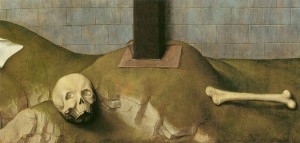 In medieval Christian folklore, the Cross was as atemporal/acausal as the blood spilling from Christ’s wounds: It was said to be hewn from the wood from the Garden of Eden, and paintings always showed the skull of Adam at its base. The fragments of the “True Cross” that circulated as priceless relics in the Middle Ages were spiritually potent (and economically valuable) sublime objects. In a sense, Christ has always been nailed to the One True Cross he was nailed to, as a kind of endlessly circular/tautological (and thereby Real) emblem of what Gnostics called the “fall of spirit into matter.”
In medieval Christian folklore, the Cross was as atemporal/acausal as the blood spilling from Christ’s wounds: It was said to be hewn from the wood from the Garden of Eden, and paintings always showed the skull of Adam at its base. The fragments of the “True Cross” that circulated as priceless relics in the Middle Ages were spiritually potent (and economically valuable) sublime objects. In a sense, Christ has always been nailed to the One True Cross he was nailed to, as a kind of endlessly circular/tautological (and thereby Real) emblem of what Gnostics called the “fall of spirit into matter.”
The blood that spilled and still spills from Christ as a result of this fixation both to matter and symbolism (which may be the same thing) is really pure enjoyment, and it may be both the cause of our suffering and our salvation depending on whether or not we embrace it—that is, whether we are the “good thief” asking to be remembered by Christ (and thus being saved) or are the unrepentant “bad thief” unwilling to give up our concepts and thus bound for eternal suffering. As any Buddhist would explain, “no self” is excruciating trauma from the standpoint of our clung-to symbolic/conceptual ego-worlds (i.e., “the unbearable lightness of being”), but it is bliss when our symbols are given up within the Real of meditation or nondual mystical experience.
Enjoyment Versus Consciousness
The Grail has always been the symbol of this interconversion not only of Time into Space (as Wagner and Dick understood) but, firstly of Enjoyment into Time. After all, what is the Grail/Eucharist Cup but the vessel that changes wine into Christ’s blood—symbolically expressing the changing of mundane convivial enjoyment (as at a dinner party) into the very traumatic/saving stuff of salvation and history? Because time flows in both directions or simply doesn’t exist in the vicinity of the Real, the opposite conversion is also possible.
You could also say that linear non-reversing Time is tantamount to lost or displaced (past/future) enjoyment. The curvature or distortion of Kantian categories (Space and Time) generates enjoyment, which we displace and symbolically domesticate as a linear causal progression and log/accession in our memorial brains as “history.” But when we give in to enjoyment (be the good thief), we may literally step outside of history and commune with the past and future.
Although Žižek steers way clear of linking his (or Lacan’s) theoretical framework to mysticism or Gnosticism (which he dismisses as ‘New Age obscurantism’), his theory of symptoms very nearly corresponds to Dick’s theory of orthogonal (or fifth-dimensional) Time: A symptom is an eddy in the spacetime continuum, a vortex or whirlpool in which the patient’s enjoyment is trapped and cannot move forward until interpretation releases it. That interpretation, the enunciation of the meaning that gave rise to the symptom in the first place, is like the spear that pierced Christ’s side and that gave rise to Anfortas’s wound; it is the object that caused it and will heal it too, according to a kind of time-loop paradox. Thus the cure of the symptom (the best “salvation” that can be hoped for in psychoanalysis) is a substance, like light or enjoyment or Christ’s blood, that is outside of history’s temporal flow.
Symptoms, these enjoyment traps, are “caused by the future” in the sense that reordering the symbolic world to give them meaning (and hopefully dissolve them) actually transforms the past, un-does their traumatic cause, because the only place history is encoded or persists is in the ever-changing order of symbols and meanings. There is no “objective” history outside of the constantly shifting order of symbols, and there are real places where this order dissolves and breaks down. The only thing that is really permanent is enjoyment itself, which exists in these singularities of the Real, outside the bounds of the known.
If we take that idea literally and seriously, it potentially offers a rich theory not only of mysticism but also of synchronicity, paranormal phenomena, and the relationship between mind and causality. I would suggest that the enjoyment Žižek’s sublime objects and Dick’s common constituents are made of is precisely the “nonlocal” field or substance sought by theorists of ESP, for example, as well as countless writers lately seeking to replace modern reductive materialism with some better theory that privileges Mind or consciousness.
If Time and enjoyment are interconvertible, then enjoyment, not the vague catch-all “consciousness,” may be real ground or substrate of being, and the missing link in current attempts to reconcile mind and material causality. Or, enjoyment might be understood as a kind of purified, rarified consciousness—the quintessence of consciousness—which would correspond to countless mystics’ descriptions of the ocean of nondual bliss-awareness awaiting us in deep meditative states. (I’ll return to this subject in future posts.)
When Is It Hyperfootball Season?—Rethinking Eternalism

There are rumblings from the Internet that graphic novelist and magus Alan Moore is soon to drop a million-word novel on the world, called Jerusalem. It shows great courage and faith, in a world that no longer reads books, that Moore has stretched out his text as much as possible instead of compressing his ideas to the size of a tweet, which is the direction most people are going in. It sounds interesting. In an interview in Aeon magazine, Moore dazzles the interviewer Tim Martin with the novel’s central theme, eternalism:
In essence, eternalism proposes that space-time forms a block—‘imagine it as a big glass football’, Moore suggests—where past and future are endlessly, immutably fixed, and where human lives are ‘like tiny filaments, embedded in that gigantic vast egg’. He gestures around him at the rubbish-strewn path, his patriarch’s beard waving in the wind. ‘What it’s saying is, everything is eternal,’ he tells me. ‘Every person, every dog turd, every flattened beer can—there’s usually some hypodermics and condoms and a couple of ripped-open handbags along here as well—nothing is lost. No person, no speck or molecule is lost. No event. It’s all there for ever. And if everywhere is eternal, then even the most benighted slum neighbourhood is the eternal city, isn’t it? William Blake’s eternal fourfold city. All of these damned and deprived areas, they are Jerusalem, and everybody in them is an eternal being, worthy of respect.’
The notion is that, if we could step outside of our puny three-dimensional Now and see all of cosmic history at once, we could see how every particle in the cosmos has a world line extending from one end to the other, dividing and interweaving and then recombining. We can imagine sliding back and forth along our own world line into the past and future, like scrubbing the cursor back and forth in a video-editing timeline, because everything from the Big Bang to the Big Crunch (the two tips of Moore’s football) is permanent.
 But is permanence the only reason something is worthy of respect? Is a slum the same as Jerusalem only if it persists eternally? This was Nietzsche’s idea with his notion of Eternal Recurrence: Things matter, assume some kind of ontological substantiality, if they repeat endlessly. Nietzsche’s thought experiment was also the theme of Milan Kundera’s great novel The Unbearable Lightness of Being: If there is no repetition or permanence, life is like a sketch that is never filled in. Impermanence is a notion that can drive some to despair; some would say that if they only happen once, then they might as well not have happened at all (which is why Kundera described it as “unbearable”).
But is permanence the only reason something is worthy of respect? Is a slum the same as Jerusalem only if it persists eternally? This was Nietzsche’s idea with his notion of Eternal Recurrence: Things matter, assume some kind of ontological substantiality, if they repeat endlessly. Nietzsche’s thought experiment was also the theme of Milan Kundera’s great novel The Unbearable Lightness of Being: If there is no repetition or permanence, life is like a sketch that is never filled in. Impermanence is a notion that can drive some to despair; some would say that if they only happen once, then they might as well not have happened at all (which is why Kundera described it as “unbearable”).
I don’t agree. I like Alan Moore a lot, but whenever I read anything by him (even an interview), I get the weird sense I’m in the presence of a hoarder. (Am I the only one who has this feeling?) While the concept of eternalism is appealing on one level, I think it’s also a very cramped, claustrophobic model of time and ethics that actually precludes anything truly interesting from happening in the universe—including phenomena that Alan Moore fans themselves enjoy, such as synchronicities and magic. It also doesn’t really leave any breathing room for consciousness or free will.
I’d suggest that spacetime is much weirder and more interesting than a football, and that respect for every stray beer can and syringe—not to mention every person or animal—is perfectly possible even if they don’t last.
Trapped in Amber
A solid glass-block universe, which was originally formulated by Einstein’s teacher Minkowski in 1908, is one in which the crude truism about the impossibility of killing your own grandfather—or, more subtly, altering the course of a single particle in a butterfly-effect universe—holds sway. In such a universe, linear causality is ironclad, and thus it is implicitly materialistic and deterministic.

It is some vague notion of the glass football, where everything is eternally preserved like flies in amber, that prevents materialist hard-liners from ever accepting the possibilities suggested by various paranormal phenomena like precognition, which necessitate that information can in some form travel from the future into the past and affect the unfolding of events. Such experiences, even if they are seldom actually useful, are too numerous in our lives and too well-attested even in scientific research to deny. (Having lately taken the ‘J.W. Dunne challenge’ and systematically scrutinized my own dream life for fine-grained evidence of precognition—and not only memory encoding—I am now even more persuaded that our relationship to time is way more complicated than our commonsense models of causality admit.)
The multiverse theory that physics increasingly allows as a loophole in these rules isn’t very satisfying: Instead of an actual alteration of history, any deviation from the glass football just spawns a new, different glass football. If you go back or make some alteration in the crystalline spacetime structure, you are actually giving birth to a new universe with an altered history, not affecting the original one. If you go back and time and kill your Grandfather, in other words, it does not produce a paradox because you have actually killed an alternate-universe Grandfather and not the one from your origin universe; likewise, information from the future in a precognitive dream would actually be information from a different future, and thus highly suspect.
But the main problem is, the four-D glass football does not include the knower in the known—who’s the guy holding the football? Where is he? When is he? In a glass football universe, the consciousness of anyone venturing back along the timestream to collect or recollect one of those beer cans (along with everyone else’s consciousness and indeed every material configuration, the position of every particle) would itself “travel” back in time, making the whole notion of travel meaningless—merely an idea in somebody’s head at a particular point in time, a pure fiction or metaphor with no basis in reality. The very idea of the glass football becomes meaningless if there is a single temporal dimension, because there is no external vantage point from which to even verify its truth or falsity.
Eddies in the Space-Time Continuum
“Time is a sphere, and I have been reincarnated in the same time at which I exist!” —Bachman, Silicon Valley
Many physicists would now say that there are more dimensions than the ones we’re aware of. Even if space itself isn’t as voluptuous as we may think (as I suggested in my post on anamorphosis), there may be more than one temporal dimension. If there is even just a second dimension of time, then the glass football suddenly becomes a hyperfootball, and all bets are off.
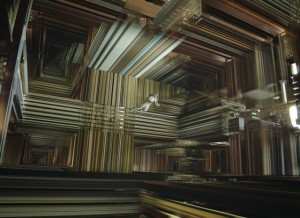 A hyperfootball is much more interesting than a football, any day of the week, even on Sunday. First of all, history may spiral back and intersect and interpenetrate itself in all kinds of ways that are impossible to visually represent. If there are three temporal dimensions, history could even have volume. A looping, thick, or even turbulent historical/causal stream would produce some very strange effects and phenomena, things appearing to defy our expectations of causality. A “tesseract” such as that depicted in the movie Interstellar is just one possible way of imagining the possibilities.
A hyperfootball is much more interesting than a football, any day of the week, even on Sunday. First of all, history may spiral back and intersect and interpenetrate itself in all kinds of ways that are impossible to visually represent. If there are three temporal dimensions, history could even have volume. A looping, thick, or even turbulent historical/causal stream would produce some very strange effects and phenomena, things appearing to defy our expectations of causality. A “tesseract” such as that depicted in the movie Interstellar is just one possible way of imagining the possibilities.
There could be Douglas Adams’ famous “eddies in the space-time continuum.” Event-streams could move at an angle to ours, intersecting obliquely or perpendicularly, semi-overlapping. History could even become “frothy” if the temporal flow becomes turbulent rather than laminar. In the folds or froth, where our limited sensory apparatus detects multiple converging time streams, we might encounter “flickers,” glitches in the matrix, synchronicities, and multistable phenomena—either/or or both/and structures, about which no two witnesses would agree. Sound familiar? People could reincarnate into the past, or even into the present (like Silicon Valley’s Bachman).
We might even experience a sense of living in two times at once.
 The latter was precisely the experience Philip K Dick had in the mid-1970s and that forms the basis for his 900+ page Exegesis, surely now the touchstone (or capstone) text for any sci-fi Gnostic cosmology. After seeing a gleaming Jesus fish around the neck of a young woman delivering pain medication to his house after a tooth extraction, he began to download information ranging from the factual (such as an undiagnosed but potentially fatal birth defect in his son) to the cosmological (such as insights into the spiral structure of time and reality). Historical configurations or events repeated, albeit with an altered appearance: Specifically, the writer became certain that the America of gas shortages and the fall of Nixon was a replay of apostolic Rome, and that Gnostic Christians were once again circulating in secret, communicating with covert symbols (i.e., the fish), and awaiting the redeemer.
The latter was precisely the experience Philip K Dick had in the mid-1970s and that forms the basis for his 900+ page Exegesis, surely now the touchstone (or capstone) text for any sci-fi Gnostic cosmology. After seeing a gleaming Jesus fish around the neck of a young woman delivering pain medication to his house after a tooth extraction, he began to download information ranging from the factual (such as an undiagnosed but potentially fatal birth defect in his son) to the cosmological (such as insights into the spiral structure of time and reality). Historical configurations or events repeated, albeit with an altered appearance: Specifically, the writer became certain that the America of gas shortages and the fall of Nixon was a replay of apostolic Rome, and that Gnostic Christians were once again circulating in secret, communicating with covert symbols (i.e., the fish), and awaiting the redeemer.
To explain this overlapping or confluence of eras, Dick attempted to think four-dimensionally about space and time, much in the vein of Moore’s eternalism, invoking Minkowski’s solid-block spacetime, but quickly he realized that four dimensions are not enough to contain the universe as he experienced it. At least five are needed. It is precisely this fifth dimension, perpendicular to the fourth, that contains the redemptive potential of the universe. But in doing so, I argue, it implicitly calls into question the permanence of every stray condom and syringe in the gutter of Moore’s Jerusalem.
The Fifth Dimension
From the standpoint of the fifth dimension, the fourth (linear time) becomes just an additional spatial dimension, perpendicular to the other three—precisely as Einstein said—but the fifth becomes a Platonic dimension of meaning or form. Early in his voluminous musings, Dick compares history to a kind of printer or typewriter (implicitly the then-popular IBM Selectric, as one of the editors notes), with this orthogonal dimension a rotating ball or a print head sliding back and forth printing out Platonic forms on the unfolding paper of history. In a much earlier era, the metaphor might have been one of warp and weft, with history as the tapestry that results from this interplay of Time and (eternal) Form—enabling a tapestry to actually show a picture, not just be rainbow-like rows of meaningless color.
 Although Dick toys with a million different theories and riffs on his core neo-Platonic cosmology in various ways across the eight-year span of the Exegesis, he eventually seems to converge on an even stranger view: that basically, there is no single history, and that certain objects or configurations—what he calls “common constituents”—do not recur so much as never alter, and thus become foci of an eternal present persisting amid change. At least, that’s how I interpret some of the late entries in his notebook. In early 1982, shortly before his death, he wrote:
Although Dick toys with a million different theories and riffs on his core neo-Platonic cosmology in various ways across the eight-year span of the Exegesis, he eventually seems to converge on an even stranger view: that basically, there is no single history, and that certain objects or configurations—what he calls “common constituents”—do not recur so much as never alter, and thus become foci of an eternal present persisting amid change. At least, that’s how I interpret some of the late entries in his notebook. In early 1982, shortly before his death, he wrote:
In this fifth dimension time, things are ‘now’ if they possess a common constituent; viz: ‘now’ signifies any and all of our fourth dimensional worlds where such a common constituent … is; … in a five dimensional world, that golden fish sign was in USA 1974 and Syria A.D. 70 simultaneously.
In other words, “common constituents,” the way Platonic ideal forms manifest in the physical world and history, give a secret structure to Time as points where the forward movement breaks down and becomes an eternal present. They are islands of permanence in a temporal river that slows down or develops eddies in their vicinity, almost like a viscous Heraclitean river with Parmenides (or perhaps several Parmenides, plural) standing defiantly out in the middle of it.
In Dick’s five-dimensional world, there would be no uniform time stream, but a gradation. Things would be shimmering and contradictory and fleeting at the periphery, but things would get more permanent the closer you get to the sublime common constituents—the zone of what might be called “grace.” Indeed isn’t there a similar tension in mainstream Christian doctrine? At the end of time, the important stuff—namely, people, or perhaps some broadened conception of humanity—is resurrected, brought back from oblivion, but the bad stuff that happened (sin) is washed away or redefined, implying a sort of cleansing of Jerusalem’s gutters.
Nostalgia for the Impossible
Events from the future do appear in my dreams, but Jerusalem has not manifested itself on my dream bookshelf, so my musings here can hardly or fairly stand as a review of that book or Moore’s ideas. But the glass football of eternalism strikes me as fundamentally a claustrophobic, hoarder’s universe, in which the price of keeping every speck or molecule is a lack of freedom to move or to breathe. The universe strikes me as being far more weird, contradictory, and incomplete than that.
 If history isn’t purely linear, then the future can affect the past—or the eternal lockstep march of time may be entirely an illusion, as indeed Einstein’s relativity theory sort of predicts: History is not exactly the same from any two points in space, even on the subatomic level. If that’s the case, there’s no single configuration of anything; history is a swirling, shimmering, flickering mess of contradictions and folds, where possibilities including stray beer cans or dog turds either are or aren’t depending on where you stand in relation to them. More importantly, determinism isn’t, well, deterministic; there’s space for free will, as well as space for consciousness that isn’t a pure fiction or emergent property of molecular-cellular interactions.
If history isn’t purely linear, then the future can affect the past—or the eternal lockstep march of time may be entirely an illusion, as indeed Einstein’s relativity theory sort of predicts: History is not exactly the same from any two points in space, even on the subatomic level. If that’s the case, there’s no single configuration of anything; history is a swirling, shimmering, flickering mess of contradictions and folds, where possibilities including stray beer cans or dog turds either are or aren’t depending on where you stand in relation to them. More importantly, determinism isn’t, well, deterministic; there’s space for free will, as well as space for consciousness that isn’t a pure fiction or emergent property of molecular-cellular interactions.
The five-or-more-dimensional universe where history shifts and shimmers—the universe of the impossible—is radically susceptible to alteration and change, and to gnosis. It includes a space for the knower.
Think about it: Which is more important to you, your freedom or the ability to go back and recover every lost beer can? While it’s a nice idea to want to commemorate everything and to think it’s all still there somewhere, somehow, it’s only impermanence that opens a space not only for free will and consciousness but also (I would suggest) true compassion. Without the shimmering space between the is and the was and the might have been, the universe would be claustrophobic and hyper-determined.
Impermanence (or more radically, impossibility) can indeed be physically painful to accept. It can feel unbearable … but so can stubbing your toe—for the first few seconds. But it’s not really unbearable. Once you push through the discomfort, it can also make things beautiful in a new way. In Zen-steeped Japan they have a term, mono no aware, for a sort of “nostalgia in the moment,” an elegaic mood that savors the passing away of things even as they are happening. I don’t know if there’s a word for a kind of nostalgia for things that don’t exist at all, a nostalgia for the impossible, but there should be one of those too.
I think it’s shortsighted to require permanence and eternity in order to respect everything that happens and passes away. It makes our respect (or compassion) that much more noble, I think, if it and its objects are ultimately unrecorded and unrewarded, and maybe even unreal. We respect them anyway. That’s our superpower as humans.
The Real Infinite Improbability Drive: Cloaking Devices, UFOs, and ESP
Away in front of them a huge white dome that bulged against the sky cracked down in the middle, split, and slowly folded itself down into the ground. …
Beneath it lay uncovered a huge starship, one hundred and fifty metres long, shaped like a sleek running shoe, perfectly white and mindboggingly beautiful. At the heart of it, unseen, lay a small gold box which carried within it the most brain-wrenching device ever conceived, a device which made this starship unique in the history of the galaxy, a device after which the ship had been named—The Heart of Gold.
“Wow”, said Zaphod Beeblebrox to the Heart of Gold. There wasn’t much else he could say…
More and more reports are emerging about advances in cloaking technology. Since Star Trek we’ve all been familiar with the concept of camouflaging objects in space; last week there was news about, of all things, “time cloaking,” although the principle was evidently first demonstrated at MIT a few years ago. A time cloak causes photons to halt before an event and then continue on their way afterward, like cars stopping for a pedestrian at a crosswalk, effectively (and mind-blowingly) making it as though the event/pedestrian never happened.
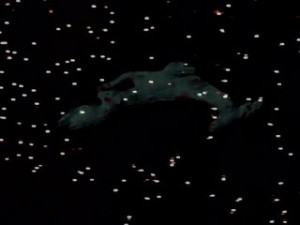 These advances are coinciding with an interest in “cloaked UFOs,” and it might be worth asking if there could be a connection between cloaking and the famed mysteries of UFO propulsion. So here’s another in my series of what might be called “unthinking antigravity”—attempts to escape the usual conceptual boxes of ufology: What if cloaking is not just a defensive camouflage mechanism but is actually an intrinsic part of how UFOs (and someday, our own space-and-time vessels) get around?
These advances are coinciding with an interest in “cloaked UFOs,” and it might be worth asking if there could be a connection between cloaking and the famed mysteries of UFO propulsion. So here’s another in my series of what might be called “unthinking antigravity”—attempts to escape the usual conceptual boxes of ufology: What if cloaking is not just a defensive camouflage mechanism but is actually an intrinsic part of how UFOs (and someday, our own space-and-time vessels) get around?
Douglas Adams’ “Heart of Gold” (from The Hitchhiker’s Guide to the Galaxy) provides a possible clue to the quantum mechanical reasons why an advanced hyperdrive might actually be tantamount to a cloaking device.
“…the most brain-wrenching device ever conceived”
The Heart of Gold is powered, Adams writes, by improbability itself:
The Infinite Improbability Drive is a wonderful new method of crossing interstellar distances in a few seconds; without all that tedious mucking about in hyperspace. As the Improbability Drive reaches infinite improbability, it passes through every conceivable point in every conceivable universe almost simultaneously. In other words, you’re never sure where you’ll end up or even what species you’ll be when you get there. It’s therefore important to dress accordingly.
The question becomes: How do you reach such a state of improbability? Obviously, the same way Schrödinger’s cat does: by hiding in a box. Adams never reveals the brain-wrenching secret hidden at the heart of the Heart of Gold, but it must be a cloaking device.
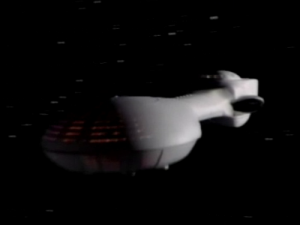 According to the “Copenhagen Interpretation” of quantum mechanics (or at least some interpretations of the Interpretation), the collapse of a particle’s wave (probability) function requires that there be an observer to measure (localize) it. In plainer terms: A state of affairs needs to be seen by someone in order to become real or actual. As long as waves/particles (or by extension, all the particles making up a starship) can’t be seen and measured, they theoretically remain in an indeterminate state, all possibilities (and all possible locations in spacetime) at once.
According to the “Copenhagen Interpretation” of quantum mechanics (or at least some interpretations of the Interpretation), the collapse of a particle’s wave (probability) function requires that there be an observer to measure (localize) it. In plainer terms: A state of affairs needs to be seen by someone in order to become real or actual. As long as waves/particles (or by extension, all the particles making up a starship) can’t be seen and measured, they theoretically remain in an indeterminate state, all possibilities (and all possible locations in spacetime) at once.
What if UFOs somehow expand their “spacetime potentiality” by shielding themselves from observation and measurement, using a powerful cloaking device, effectively turning themselves into Schrödinger’s cat?
This idea occurred to me in a completely unrelated context, psychic healing. In his excellent book Limitless Mind, former SRI remote-viewing researcher and laser physicist Russell Targ hypothesizes that psychic healing may have greater effectiveness prior to a firm diagnosis. For instance, taking a picture of a cancer using an MRI might “lock in” a state of affairs in the body that had previously remained in the more psychically tractable realm of uncertainty. The diagnosis essentially “collapses its wave function” and adds to the disease’s resistance to psychic or non science-based therapies.
That sensation you just experienced was the telepathic awareness of a million materialist physicians crying out in shock and rage at the implications of Targ’s suggestion. I’m not sure what I think of this idea when it comes to approaching health and illness, but the notion seems like it could make good sense of UFO locomotion: A fully cloaked vessel could exist temporarily as a vast wave function in some nonlocal, indeterminate, probabilistic (or possibilistic) state of uncertainty from which it is therefore possible to reemerge anywhere, anywhen, and in any form—just like Zaphod Beeblebrox’s mindbogglingly beautiful spaceship.
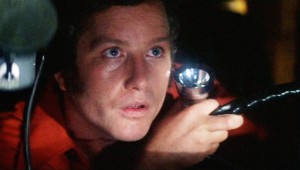 There’s an important entailment of this hypothesis that could make sense of some peculiarities of the UFO phenomenon: While a vessel in transit would temporarily exist as an unmeasured and unmeasurable fan of possibilities, it would actually require an external observer to be able to materialize (or become actual) at its destination. In other words, the observer/witness could be an intrinsic part of UFO travel, not an accident.
There’s an important entailment of this hypothesis that could make sense of some peculiarities of the UFO phenomenon: While a vessel in transit would temporarily exist as an unmeasured and unmeasurable fan of possibilities, it would actually require an external observer to be able to materialize (or become actual) at its destination. In other words, the observer/witness could be an intrinsic part of UFO travel, not an accident.
Could this be why so many UFO sightings seem to be almost staged? Could this account for all the bright lights? Might a witness or bystander actually be essential for a UFO to “land” in our reality?
Uncertainty: UFO and ESP Fuel
Famously, the head of Lockheed’s Skunk Works is reported to have hinted that UFO propulsion is based on ESP principles. Nonlocality (the interconnection of everything) has been the assumed interpretation of that statement, but according to the hypothesis I’m suggesting, it might really be uncertainty—since uncertainty is the state a shy cat or fully cloaked starship would be in quantum-mechanically. (With all due respect to Adams, we’d probably need to rename his invention an “infinite uncertainty drive.”)
 Uncertainty happens also to be intrinsic to psychic phenomena, and it is a constant frustration for those who would seek to pin these phenomena down and study them scientifically. Uri Geller was a prime example of this. As Jonathan Margolis shows in his excellent biography
Uncertainty happens also to be intrinsic to psychic phenomena, and it is a constant frustration for those who would seek to pin these phenomena down and study them scientifically. Uri Geller was a prime example of this. As Jonathan Margolis shows in his excellent biography, Geller perpetually convinced people, including most of the scientists who ever actually worked with him, that there was a genuine core to his abilities; yet he perpetually frustrated these professionals by being so committed to what they saw as shallow showmanship—and often his most amazing feats proved recalcitrant to actual recording or measurement. His signature trick of spoon-bending, for instance, was never filmed when he wasn’t touching the spoon, even though witnesses consistently reported the latter feat when cameras weren’t running.
To be fair, Geller himself was always a bit uncomfortable claiming those powers as his own; they seemed to happen around and through him, and there was always something “tricksterish” about it. Either Geller himself instinctively knew, or the powers working through him knew, that measurement was the enemy. I’m persuaded his “powers” were not a fraud, as James Randi has made his career claiming, but they did only function within an atmosphere of unpredictability and uncertainty—or they even fed on it—and Geller was not above using standard stage-magic legerdemain to help preserve that (a common phenomenon known as “mixed mediumship”).
According to Margolis, Geller has actually always been drawn to those who doubt him, and this is true of other magic men throughout history: They have always functioned and even thrived within an aura of uncertainty, and often even entered into their profession via determined skepticism. Many shamans, for example, begin their careers as debunkers; they then learn not only the “tricks” of the trade, but also the genuine paranormal power cloaked and even protected by that trickery. Because uncertainty is intrinsic to the shaman’s power, there will always be James Randis throwing skeptical stones. The Gellers need the Randis as much as the Randis need the Gellers. It’s the Trickster logic of anything that draws from uncertainty’s well.
Including the Unknower in the Unknown
But the poetic cliche that science kills the world of magic is also precisely right: Science may be an encroachment on this other “quantum” form of prediction and control, and while interdependent in one sense, they are also inherently incompatible. I say “forms of prediction and control” and not “ways of knowing” because shamanic magic (to put a label on it) is really a path that depends upon strategic unknowing.
 Suggestive clues are many here, and include the well-known power of nonconceptual and wordless thinking advocated by mystics and meditators, the hermetic value placed on silence and secrecy, and the observation by modern shamans (e.g., remote viewers) that “things that have been hidden shine like beacons in psychic space,” as star SRI psychic Pat Price put it. What is lost in the inability to know a thing with certainty is a gain when it comes to visualizing a thing in the fuzzy realm of the uncertain-but-probable.
Suggestive clues are many here, and include the well-known power of nonconceptual and wordless thinking advocated by mystics and meditators, the hermetic value placed on silence and secrecy, and the observation by modern shamans (e.g., remote viewers) that “things that have been hidden shine like beacons in psychic space,” as star SRI psychic Pat Price put it. What is lost in the inability to know a thing with certainty is a gain when it comes to visualizing a thing in the fuzzy realm of the uncertain-but-probable.
The reverse ought also to be true. If I were Russell Targ and Hal Puthoff in the 1970s at SRI, I would like to have performed the following experiment: Ask Price or Ingo Swann to remote view the fate of photons in a double-slit experiment. My hypothesis: They would not see the outcome (i.e., the famed collapse of the wave function), but instead would see a gray indeterminacy or a multistable flicker of possibilities, like a visual duck/rabbit … because clairvoyance is not the kind of observation uncertain waves/particles are looking for in order to land in the actual. (That’s just a hunch.)
In any case, if we were to formulate a theoretical principle here, it would be something like this: That “the paranormal” encompasses phenomena that for one reason or another, intentionally or accidentally, are recalcitrant to measurement/observation, and this observation-resistance either gives them their power or is involved in their power, on the model of quantum decoherence and the collapse of the wave function.
Whether or not there are really such things as “cloaked UFOs” isn’t really the point: They are a useful imaginary tool for probing the boundaries of thought, and the meaning of occult. That vexingly polyvalent term, which simply means “hidden,” is on one hand just a bookstore label that unifies diverse uncertain and tricksterish topics under its uneasy umbrella. With all those topics, there’s an ambiguity as to whether the thing is being hidden from view because it would be persecuted otherwise (e.g., witchcraft), whether it is overlooked because no one takes it seriously (e.g., UFOs and ESP), or whether it has to be concealed in order to function.
In European alchemy, for instance, there has always been a suggestion that the cloaking of secrecy was somehow intrinsic to its power; for the great 20th-century adept Fulcanelli, the massive subterranean foundations of French cathedrals and the black Madonnas often found down in those crypts symbolized the dependence of the Great Work on obscurity: “Real, but occult, power, which is exercised in secret, develops in the darkness, toils without respite in the deep foundations of the work.”
Consciousness Inside-Out: Wormhole UFOs, the Hill Abduction, and Interstellar
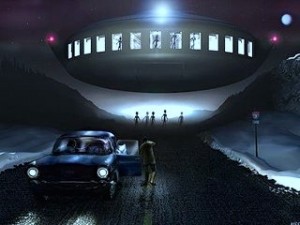
Jacques Vallee has been saying for years that our materialistic fetishism for the nuts-and-bolts secrets of UFO propulsion is a block on our imagination and a hindrance to scientific understanding of the phenomenon; there are countless other possibilities besides ‘alien spaceships propelled by antigravity.’ Thinking differently about how our visual system interprets anomalous phenomena can help illuminate some of these other possibilities. Special effects can be useful in this effort, producing breakthroughs in how we see the problem in our mind’s eye.
For example, the idea of portals and gateways is a popular one currently, yet writers mainly still operate on the mental model of aerial vessels or beings passing through these portals. But this could be missing the point. A portal itself, as shown by the intergalactic wormhole in Interstellar, would appear visually as a convex, three-dimensional object having volume, not as a “hole” or doorway. This raises the possibility that some UFOs could themselves be small wormholes generated by a machine in some advanced laboratory somewhere (or somewhen).
If this is the case, the visible exterior of a “flying saucer” might actually be the inner chamber of a wormhole-making machine.
Innies That Look Like Outies
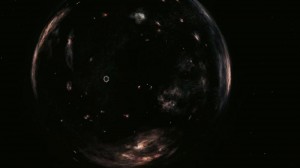 Interstellar showed how a wormhole in space would look from a distance a lot like a glass Christmas tree ornament (right). The refracted light of stars seen through and beyond it would be interpreted visually as reflected light, as off a shiny object. As you approached and lost sight of the “rim” in your peripheral vision you would see that there was actually no surface and that the convex appearance had been an optical illusion.
Interstellar showed how a wormhole in space would look from a distance a lot like a glass Christmas tree ornament (right). The refracted light of stars seen through and beyond it would be interpreted visually as reflected light, as off a shiny object. As you approached and lost sight of the “rim” in your peripheral vision you would see that there was actually no surface and that the convex appearance had been an optical illusion.
A wormhole created in the high-tech laboratory of some future “Wormhole Inc.” would look very different. It would not show stars beyond it but simply the insides of the machine or chamber generating the wormhole. Thus, it might look metallic, perhaps something like a big vacuum chamber in a physics lab turned inside-out. Visually, from a safe distance, it would appear solid and round because we would interpret its surface as convex (pushing toward us). Only as you approached it—or as it approached you—would its perspective seem to distort and your senses might finally realize you were seeing into the insides of a machine or chamber of some sort.
More likely, of course, you would be too confused, frightened, and upset by the encounter to “realize” anything at all. You would lack any precedent in your experience for such a phenomenon—or even any sci-fi special effect to relate it to.
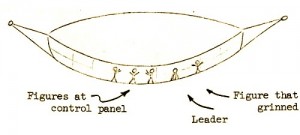 Consider the classic archetypal flying saucer or lozenge with windows around the rim, maybe with occupants looking out, as described by Betty and Barney Hill after their famous abduction (left). This seems like what a circular wormhole-creating chamber with observation windows looking into it might look like. The figures “watching out the windows” of the flying saucer could actually be proud technicians peering into their wormhole chamber.
Consider the classic archetypal flying saucer or lozenge with windows around the rim, maybe with occupants looking out, as described by Betty and Barney Hill after their famous abduction (left). This seems like what a circular wormhole-creating chamber with observation windows looking into it might look like. The figures “watching out the windows” of the flying saucer could actually be proud technicians peering into their wormhole chamber.
Wormhole Inc.
Critical ufologists like Mac Tonnies have pointed out the absurdities and inconsistencies in the Hill case—the theatrically presented star map, the not-super-high-tech (or spaceship-like) exam room, and so on. Abductees often describe interiors that are bigger on the inside than the outside or that don’t correspond well to the tightly packed and neatly arranged environment one would expect of a spacecraft. It has often been suspected that the examinations (if real) are actually taking place at an earth-bound facility somewhere, not on the “saucer.”
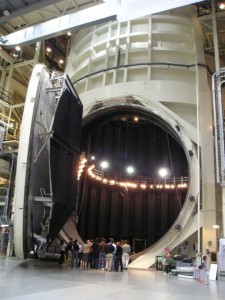 A wormhole generated in, and projected from, some large, land-based facility (e.g., on earth, in the future, or on another planet) would explain a number of things. It would eliminate the problem of packing enormous amounts of energy into a moderately sized object: If what looks like a saucer is really just the Wormhole Inc. laboratory turned inside out then it need not contain anything—no people, and no power plant.
A wormhole generated in, and projected from, some large, land-based facility (e.g., on earth, in the future, or on another planet) would explain a number of things. It would eliminate the problem of packing enormous amounts of energy into a moderately sized object: If what looks like a saucer is really just the Wormhole Inc. laboratory turned inside out then it need not contain anything—no people, and no power plant.
I am momentarily ignoring, of course, the vastly greater energy needed to create a wormhole, versus levitate a 30-foot metal disk. Current physics grants wormhole technology to Type-III civilizations capable of harnessing the energy of their whole galaxy—quite a big power plant—so my thought experiment is presuming some unforeseen technical leap or discovery making the process much more convenient.
If we do grant such a leap enabling lab-made wormholes, the theory could perhaps also help account for the laser-pointer-like motion of UFOs, which suggests they could be something insubstantial like an image being projected and stabilized in the air and not physical, massive objects actually flying. Whereas their frequent appearance on radar would make the volumetric hologram theory unlikely, a lab-made wormhole inserted into our airspace would indeed produce a radar return, albeit perhaps slightly distorted or displaced—the radar waves would simply bounce off the interior walls of the wormhole chamber and right back out. (In contrast, a space wormhole wouldn’t appear on radar because the radar waves would have nothing to bounce off of.) But the hole itself would have no mass, as the mass is all back at the lab.
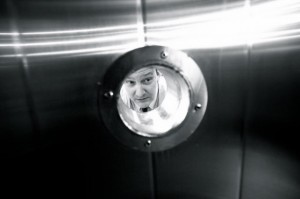 A wormhole generator also more realistically solves the more fundamental “relativistic” problem: How to bring people (e.g., relatives) to you instead of going to them—because as grown-ups realize on occasions like Thanksgiving, it’s more fun being a host than a guest. A wormhole enables you to interact with distant objects and people from the comfort of your own laboratory, not have to pack yourself into a cramped ship and go on an annoying or dangerous journey. We should bear in mind that interacting with or manipulating unwitting guests like the Hills is probably the least of a wormhole generator’s many fabulous uses.
A wormhole generator also more realistically solves the more fundamental “relativistic” problem: How to bring people (e.g., relatives) to you instead of going to them—because as grown-ups realize on occasions like Thanksgiving, it’s more fun being a host than a guest. A wormhole enables you to interact with distant objects and people from the comfort of your own laboratory, not have to pack yourself into a cramped ship and go on an annoying or dangerous journey. We should bear in mind that interacting with or manipulating unwitting guests like the Hills is probably the least of a wormhole generator’s many fabulous uses.
The World Turned Inside-Out
Beyond depicting a solution to “nuts and bolts” problems of long-distance travel, a wormhole also shows us that inside and outside are relative—one observer’s outside is another observer’s inside.
Although Interstellar was disappointing in some ways (like a clumsy script full of expository dialogue, as well as pretty lackluster spaceships), it depicted wormhole travel really well, and it also spectacularly depicted exactly the future-intervention-via-tesseract theory for paranormal phenomena that various sci-fi writers (from Madeleine L’Engle to Philip K Dick) have groped to convey in their fiction. Sometimes you need new special effects to visualize problems and produce an “aha” experience; when that happens, new solutions and new theories appear more readily.
For one thing, we are at a crux in our science and our culture when a new model is desperately needed to think about the relationship between consciousness and material reality. Much as I’m sympathetic with those who privilege consciousness against materialistic reductionism, I think a more nuanced and nonhierarchical relationship between mind and matter must be possible. A wormhole-UFO could provide such a model.
Such a beast helps us visualize, for example, how material reality is just what consciousness looks like from the outside. Matter itself isn’t the illusion, in other words—nor is consciousness. The illusion may simply be the “convex” appearance of the material world.
The word “exist” comes from the Greek eksistere, “to stand forth.” As mystics from time immemorial have insisted, the material world is a manifestation of consciousness—the self-world continuum experienced passively, as observed, rather than actively, as observing. These two aspects pass from one to the other at certain mysterious boundaries—in dreams, at death, and in paranormal phenomena (such as UFOs) that turn our outside into an inside (or vice versa) without our quite being aware how we made the passage.
